Nanoparticle-Enhanced Phase Change Materials (NPCMs) in Solar Thermal Energy Systems: A Review on Synthesis, Performance, and Future Prospects
Abstract
1. Introduction
2. Nano-Enhanced Phase Change Material (NPCM)
2.1. Thermophysical NPCM
2.2. Photonic NPCM
2.3. NPCM Fluids
2.4. Encapsulated NPCM
2.5. Phase-Engineered Nanomaterials
3. Analytical Methods for NPCMs
3.1. Mechanism-Oriented Analysis
3.1.1. Molecular Dynamics (MD) Simulation
3.1.2. Density Functional Theory
3.1.3. Characterization Method
3.2. Simulation-Based Analysis
3.2.1. Finite Element Analysis
3.2.2. Computational Fluid Dynamics
3.2.3. System Performance Simulation
3.2.4. Magnetic Field Coupling Models
4. Algorithm-Driven Optimization
4.1. Machine Learning Methods
4.2. Uncertainty Quantification Techniques
5. Techno-Economic Analysis
5.1. Cost-Benefit Analysis
5.2. Policy Incentives and Market Growth Potential
6. Conclusions and Future Work
6.1. Key Findings and Contributions
- (1)
- NPCMs improve thermal conductivity, reduce supercooling, and accelerate melting/solidification rates.
- (2)
- Various NPCM structures, such as thermophysical, photonic, fluid-based, encapsulated, and phase-engineered, enable targeted applications across different solar thermal systems.
- (3)
- Mechanism-level analysis using MD and DFT provides critical insights into nanoparticle-PCM interactions and nano-scale heat transfer behavior.
- (4)
- Techno-economic analyses confirm that NPCMs offer high cost-effectiveness, improved energy efficiency, and extended lifecycle benefits for solar energy systems.
- (5)
- The identical Cu NPs and paraffin-based NPCM structure exhibit analogous thermal property inflection points at significantly disparate Cu NP concentrations. Consequently, it is imperative to establish a rigorous simulation model to analyze the correlation between nanoparticle concentration and the thermal performance characteristics of NPCM.
- (6)
- The unit production cost of distilled water for solar distillers using NPCM can be as low as $0.00713/L, and other models of solar distillers also demonstrate good, low-carbon, and environmentally friendly economic performance.
- (7)
- The combined use of mechanistic analysis methods and simulation methods is more conducive to studying the phase change mechanism of NPCM during the melting process.
- (8)
- The combination of a finite element analysis model and experimental data is more advantageous for the analysis of the melting phase transition mechanism of NPCM under the action of a magnetic field.
- (9)
- The application of algorithm optimization and analysis methods, particularly integrated algorithmic models based on artificial neural networks (ANNs), can be harnessed to more effectively project the material configurations of devices or systems that achieve high thermal efficiency performance.
- (10)
- The incorporation of graphene materials significantly enhances the performance characteristics of PCMs. For instance, in solar still applications, it improves energy efficiency by 574.1%. Therefore, graphene and other high-performance materials should be prioritized in future NPCM research.
- (11)
- Increasing policy incentives, clean energy mandates, and investments in renewable infrastructure are accelerating the commercial potential of NPCM-based solutions.
6.2. Remaining Challenges and Future Opportunities
- (1)
- The accuracy of ideal model simulation methods, which is related to mesh size, models, quantities, and solution methods, necessitates further research to design high-precision physical simulation models and reduce interference from inaccuracies in real-world models.
- (2)
- In algorithm optimization analysis, which demands extensive data collection with accuracy being critical, the impact of varying parameter choices in different algorithms on model outcomes necessitates further exploration into constructing high-quality datasets and developing efficient, accurate algorithmic models.
- (3)
- During the experiment, the inaccuracy caused by measuring devices is inevitable, highlighting the necessity for more precise system accuracy control and making it necessary to conduct uncertainty analysis on key steps.
- (4)
- In actual solar energy system applications, unforeseen circumstances often arise during operation, so future research could integrate simulations of additional weather factors to develop a more realistic and production-oriented simulation model.
- (5)
- An intelligent optimization model for solar-powered freshwater production systems should be established, since the study of nanomaterials within a single system is limited in scope, failing to take into account the substitutability of materials and the acceptability of economic costs.
- (6)
- Although significant progress has been made in the research of thermodynamic melting associated with magnetic field convection across various fields, it is necessary to further explore the economic benefits of these findings and address the insufficient studies on the impact of eddy current characteristics in magnetic fields on the thermal properties of materials.
Author Contributions
Funding
Data Availability Statement
Conflicts of Interest
Abbreviations
| ANN | Artificial neural network |
| BA | Bat algorithm |
| BBO | Optimization based on biogeography |
| BET | Brunauer–Emmett–Teller |
| CFD | Computational fluid dynamic |
| CHTC | Convective heat transfer coefficient |
| COP | Conference of the parties |
| DFT | Density functional theory |
| DHPD | Na2HPO4·12H2O |
| DSC | Differential scanning calorimetry |
| F | Furfural |
| FEA | Finite element analysis |
| Fo | Fourier number |
| FTIR | Fourier transform infrared spectroscopy |
| GNP | Graphene nanosheets |
| GWO | Grey wolf optimization |
| IEA | International energy agency |
| IRENA | International renewable energy agency |
| L | Liquid |
| LHTES | Latent heat thermal energy storage |
| LIB | Lithium-ion battery |
| LSTM | Long short-term memory |
| MA | Myristic acid |
| MD | Molecular dynamics |
| MLP | Multilayer perceptron |
| MWCNT | Multi-walled carbon nanotube |
| NG | Nano-graphite |
| Ni@C/C | The hierarchically porous carbon structure infiltrated with Ni@graphite |
| NP | Nanoparticle |
| NPCM | Nanoparticle-enhanced phase change material |
| Nu | Nusselt |
| ODA | Octadecanol |
| OM | Oleic-acid-modified |
| PCB | Printed circuit board |
| PCM | Phase change material |
| PSO | Particle swarm optimization |
| PV | Photovoltaic |
| PVT | Photovoltaic-thermal |
| R | Resorcinol |
| RBF | Radial basis function |
| S | Solid |
| SA | Silica aerogel |
| SEM | Scanning electron microscope |
| SIMPLE | Semi-implicit method for pressure linked equations |
| SH | Sherwood number |
| TC | Thermal conductivity |
| TEM | Transmission electron microscope |
| TGA | Thermogravimetric analysis |
| TLC | Thermochromic liquid crystal |
| VMTNS | Vermiculite nanosheets |
| XGBoost | Extreme gradient boosting |
| XPS | X–ray photoelectron spectroscopy |
| XRD | X–ray diffractometer |
References
- Wang, J.; Gullo, P.; Ramezani, H. Review on the trend of ultra-low-GWP working fluids for small-capacity vapour-compression systems. Sustain. Energy Technol. Assess. 2024, 66, 103803. [Google Scholar] [CrossRef]
- Alizadeh, O. A review of ENSO teleconnections at present and under future global warming. WIREs Clim. Change 2024, 15, e861. [Google Scholar] [CrossRef]
- Rodés-Guirao, H.R.a.L. Peak Global Population and Other Key Findings from the 2024 UN World Population Prospects. Available online: https://ourworldindata.org/un-population-2024-revision?weekend-reading-link-040824/ (accessed on 1 May 2025).
- Ngagoum Ndalloka, Z.; Vijayakumar Nair, H.; Alpert, S.; Schmid, C. Solar photovoltaic recycling strategies. Sol. Energy 2024, 270, 112379. [Google Scholar] [CrossRef]
- Yu, J.; Cheng, H.; Wang, Y.; He, C.; Zhou, B.; Liu, C.; Feng, Y. Multiple shearing-induced high alignment in polyethylene/graphene films for enhancing thermal conductivity and solar-thermal conversion performance. Chem. Eng. J. 2024, 480, 148062. [Google Scholar] [CrossRef]
- Wang, J.; Hu, E.; Blazewicz, A.; Ezzat, A.W. Investigation on the long-term performance of solar thermal powered adsorption refrigeration system based on hourly accumulated daily cycles. Heat Mass Transf. 2021, 57, 361–375. [Google Scholar] [CrossRef]
- Ali, F.H.; Al-Amir, Q.R.; Hamzah, H.K.; Alahmer, A. Unveiling the potential of solar cooling technologies for sustainable energy and environmental solutions. Energy Convers. Manag. 2024, 321, 119034. [Google Scholar] [CrossRef]
- Wang, J.; Hu, E.; Blazewicz, A.; Ezzat, A.W. Simulation of accumulated performance of a solar thermal powered adsorption refrigeration system with daily climate conditions. Energy 2018, 165, 487–498. [Google Scholar] [CrossRef]
- Kasaeian, A.; Nazari, N.S.; Masoumi, A.; Shabestari, S.T.; Jadidi, M.; Fereidooni, L.; Bidhendi, M.E. A review on phase change materials in different types of solar stills. J. Energy Storage 2024, 99, 113430. [Google Scholar] [CrossRef]
- Wang, B.; Liu, Y.; Wang, D.; Song, C.; Fu, Z.; Zhang, C. A review of the photothermal-photovoltaic energy supply system for building in solar energy enrichment zones. Renew. Sustain. Energy Rev. 2024, 191, 114100. [Google Scholar] [CrossRef]
- Pintaldi, S.; Perfumo, C.; Sethuvenkatraman, S.; White, S.; Rosengarten, G. A review of thermal energy storage technologies and control approaches for solar cooling. Renew. Sustain. Energy Rev. 2015, 41, 975–995. [Google Scholar] [CrossRef]
- Suresh, C.; Saini, R.P. Review on solar thermal energy storage technologies and their geometrical configurations. Int. J. Energy Res. 2020, 44, 4163–4195. [Google Scholar] [CrossRef]
- Carnie, J.-T.; Hardalupas, Y.; Sergis, A. Decarbonising building heating and cooling: Designing a novel, inter-seasonal latent heat storage system. Renew. Sustain. Energy Rev. 2024, 189, 113897. [Google Scholar] [CrossRef]
- Zhang, X.; Yu, C.; Zhang, C. Advances in latent heat storage technology for electronic cooling. Renew. Sustain. Energy Rev. 2025, 215, 115614. [Google Scholar] [CrossRef]
- Ou, S.; Wang, P.; Yang, S.; Su, H. Thermal characteristics and energy-saving research of P-PCM FinTwall in hot summer and cold winter regions. Energy 2025, 329, 136670. [Google Scholar] [CrossRef]
- Karaağaç, M.O. Experimental investigation of a novel PCM-enhanced underfloor heating system for energy-efficient sustainable buildings. Appl. Therm. Eng. 2025, 275, 126891. [Google Scholar] [CrossRef]
- Chen, X.; Su, Y.; Zhang, Y.; Shen, J.; Xu, X.; Wang, X.; Zhou, F. Performance of thermal management system based on PCM/forked liquid-cold plate for 18650 cylindrical battery. J. Energy Storage 2024, 91, 112071. [Google Scholar] [CrossRef]
- Kurşun, B.; Balta, M.; Karabulut, K. Exploring the impact of inner and middle channel geometries on the melting rate of PCM-metal foam composition in a triplex tube heat exchanger. Therm. Sci. Eng. Prog. 2024, 51, 102621. [Google Scholar] [CrossRef]
- Palaniappan, M.; El-Shafay, A.S.; Shanmugan, S. Improving heat retention properties of steeped M-shape basin solar distillers utilizing paraffin RT50-enhanced silver nanoparticles and Manihot esculenta extracts. Desalination 2024, 586, 117836. [Google Scholar] [CrossRef]
- Gürbüz, H.; Demirtürk, S.; Akçay, H.; Topalcı, Ü. Experimental investigation on electrical power and thermal energy storage performance of a solar hybrid PV/T-PCM energy conversion system. J. Build. Eng. 2023, 69, 106271. [Google Scholar] [CrossRef]
- Manikandan, S.; Muthuvairavan, G.; Samykano, M.; Natarajan, S.K. Numerical simulation of various PCM container configurations for solar dryer application. J. Energy Storage 2024, 86, 111294. [Google Scholar] [CrossRef]
- Ji, C.; Liu, D.; Waqas, H.; Sun, S.-L.; Jalili, B.; Abdelmohimen, M.A.H. Melting performance of Molten Salt with nanoparticles in a novel triple tube with leaf-shaped fins. Case Stud. Therm. Eng. 2024, 61, 105063. [Google Scholar] [CrossRef]
- Ma, T.; Li, Z.; Lv, K.; Chang, D.; Hu, W.; Zou, Y. Design and performance analysis of deep peak shaving scheme for thermal power units based on high-temperature molten salt heat storage system. Energy 2024, 288, 129557. [Google Scholar] [CrossRef]
- Reddy, B.D.; Rahul, S.V.S.; Harish, R. Impact of fin number and nanoparticle size on molten salt NanoPCM melting in finned annular space. J. Energy Storage 2023, 72, 108705. [Google Scholar] [CrossRef]
- Gui, X.; Wang, S.; Ding, L. Simulation study of a novel phase change cooling garment for electricians in a high-temperature environment. Int. J. Refrig. 2024, 168, 79–88. [Google Scholar] [CrossRef]
- Anter, A.G.; Sultan, A.A.; Hegazi, A.A.; El Bouz, M.A. Thermal performance and energy saving using phase change materials (PCM) integrated in building walls. J. Energy Storage 2023, 67, 107568. [Google Scholar] [CrossRef]
- Madurai Elavarasan, R.; Nadarajah, M.; Pugazhendhi, R.; Gangatharan, S. An experimental investigation on coalescing the potentiality of PCM, fins and water to achieve sturdy cooling effect on PV panels. Appl. Energy 2024, 356, 122371. [Google Scholar] [CrossRef]
- Zhan, H.; Mahyuddin, N.; Sulaiman, R.; Khayatian, F. Phase change material (PCM) integrations into buildings in hot climates with simulation access for energy performance and thermal comfort: A review. Constr. Build. Mater. 2023, 397, 132312. [Google Scholar] [CrossRef]
- Gado, M.G. Thermal management and heat transfer enhancement of electronic devices using integrative phase change material (PCM) and triply periodic minimal surface (TPMS) heat sinks. Appl. Therm. Eng. 2025, 258, 124504. [Google Scholar] [CrossRef]
- Madurai Elavarasan, R.; Pugazhendhi, R.; Shafiq, S.; Gangatharan, S.; Nadarajah, M.; Shafiullah, G.M. Efficiency enhancement of PV panels with passive thermal management using PCM: An exhaustive review on materials, designs and effective techniques. Appl. Energy 2025, 382, 125217. [Google Scholar] [CrossRef]
- Anya, B.; Mohammadpourfard, M.; Akkurt, G.G.; Mohammadi-Ivatloo, B. Exploring geothermal energy based systems: Review from basics to smart systems. Renew. Sustain. Energy Rev. 2025, 210, 115185. [Google Scholar] [CrossRef]
- Suo, Y.; Tang, C.; Jia, Q.; Zhao, W. Influence of PCM configuration and optimization of PCM proportion on the thermal management of a prismatic battery with a combined PCM and air cooling structure. J. Energy Storage 2024, 80, 110340. [Google Scholar] [CrossRef]
- Al-Amayreh, M.I.; Alahmer, A. Efficiency enhancement in direct thermal energy storage systems using dual phase change materials and nanoparticle additives. Case Stud. Therm. Eng. 2024, 59, 104577. [Google Scholar] [CrossRef]
- Murali, G.; Ramani, P.; Murugan, M.; Elumalai, P.V.; Ranjan Goud, N.U.; Prabhakar, S. Improved solar still productivity using PCM and nano-PCM composites integerated energy storage. Sci. Rep. 2024, 14, 15609. [Google Scholar] [CrossRef]
- Kazaz, O.; Abu-Nada, E. Thermal performance of nano-architected phase change energetic materials for a next-generation solar harvesting system. Energy Convers. Manag. 2025, 327, 119541. [Google Scholar] [CrossRef]
- Ulker, N.; Bulut, H.; Demircan, G. Comparative study on the effect of surface-modified nanoparticles on PCM for solar energy applications. J. Therm. Anal. Calorim. 2024, 149, 12053–12070. [Google Scholar] [CrossRef]
- Bestas, S.; Aktas, I.S.; Bayrak, F. A bibliometric and performance evaluation of nano-PCM-integrated photovoltaic panels: Energy, exergy, environmental and sustainability perspectives. Renew. Energy 2024, 226, 120383. [Google Scholar] [CrossRef]
- Goel, V.; Dwivedi, A.; Kumar, R.; Kumar, R.; Pandey, A.K.; Chopra, K.; Tyagi, V.V. PCM-assisted energy storage systems for solar-thermal applications: Review of the associated problems and their mitigation strategies. J. Energy Storage 2023, 69, 107912. [Google Scholar] [CrossRef]
- Abdolahimoghadam, M.; Rahimi, M. The effect of the number of tubes on the charging and discharging performances of a novel bio-nPCM within a vertical multi-tube TES system. Energy 2025, 319, 135010. [Google Scholar] [CrossRef]
- Dhivagar, R.; Singh, P.K.; Nandhakumar, E. Synergistic effect of stearic acid/bismuth oxychloride/cupric oxide for thermal storage applications: Preparation, stability, rheological and thermophysical analysis. Phys. Scr. 2024, 99, 065039. [Google Scholar]
- Azeez, H.L.; Ibrahim, A.; Ahmed, B.O.; Dol, S.S.; Al-Waeli, A.H.A.; Jaber, M. Experimental evaluation of a novel photovoltaic thermal System: Energy, economic, and exergy-based sustainability analysis. Case Stud. Therm. Eng. 2025, 71, 106167. [Google Scholar] [CrossRef]
- Ahmed, B.O.; Ibrahim, A.; Azeez, H.L.; Dol, S.S.; Al-Waeli, A.H.A.; Jaber, M. Energy and exergy analysis of a newly designed photovoltaic thermal system featuring ribs, petal array, and coiled twisted tapes: Experimental analysis. Case Stud. Therm. Eng. 2024, 63, 105388. [Google Scholar] [CrossRef]
- Maseer, M.M.; Ismail, F.B.; Kazem, H.A.; Hachim, D.M.; Al-Gburi, K.A.H.; Chaichan, M.T. Performance enhancement of photovoltaic/thermal collector semicircle absorber tubes using nanofluid and NPCM. Renew. Energy 2024, 233, 121152. [Google Scholar] [CrossRef]
- Máñez-Espina, L.M.; Díaz-Rubio, A. Control of the local and nonlocal electromagnetic response in all-dielectric reconfigurable metasurfaces. Phys. Rev. Appl. 2024, 22, 054022. [Google Scholar] [CrossRef]
- Sathishkumar, A.; Sundaram, P.; Prabakaran, R.; Kim, S.C. Graphene based fatty acid phase change material as an alternative to water: An experimental investigation on thermal energy storage characteristics. Colloids Surf. A Physicochem. Eng. Asp. 2025, 715, 136589. [Google Scholar] [CrossRef]
- Baiju, V.; Priya, K.L.; Shafi, K.A.; Shahid, P.A.M.; Lamba, R.; Singh, H.; Ichiyanagi, M.; Suzuki, T.; Shajan, S. Enhanced latent heat storage for solar thermal applications using tapered fins and hybrid nano-additives. J. Energy Storage 2025, 118, 116308. [Google Scholar] [CrossRef]
- Wu, Z.; Shao, Y.; Li, M.; Zou, M.; Wu, K.; Chen, W.; Huang, X.; Ma, C.; Ran, J. Stability and discharging performance improvements of modified nano particle enhanced binary alkanes capsule for cold latent heat storage tank. J. Energy Storage 2025, 117, 116169. [Google Scholar] [CrossRef]
- Shijina, S.S.; Akbar, S.; Sajith, V. Graphene functionalized nano-encapsulated composite phase change material based nanofluid for battery cooling: An experimental investigation. Appl. Therm. Eng. 2025, 259, 124893. [Google Scholar] [CrossRef]
- Sivashankar, M.; Selvam, C.; Suresh, S. Experimental study on the performance of low concentrated solar photovoltaic system with nano-enhanced phase change material encapsulated heat sink. Appl. Therm. Eng. 2025, 262, 125254. [Google Scholar] [CrossRef]
- Sutheesh, P.M.; Thomas, R.; Bandaru, R. Battery thermal management systems by using DI water and PCF with Nano-encapsulated Tetradecan-1-ol for Lithium-ion batteries. Int. Commun. Heat Mass Transf. 2025, 165, 108992. [Google Scholar] [CrossRef]
- Han, Y.; Wang, L.; Cao, K.; Zhou, J.; Zhu, Y.; Hou, Y.; Lu, Y. In Situ TEM Characterization and Modulation for Phase Engineering of Nanomaterials. Chem. Rev. 2023, 123, 14119–14184. [Google Scholar] [CrossRef]
- He, Q.; Sheng, B.; Zhu, K.; Zhou, Y.; Qiao, S.; Wang, Z.; Song, L. Phase Engineering and Synchrotron-Based Study on Two-Dimensional Energy Nanomaterials. Chem. Rev. 2023, 123, 10750–10807. [Google Scholar] [CrossRef]
- Liu, X.; Shan, J.; Cao, T.; Zhu, L.; Ma, J.; Wang, G.; Shi, Z.; Yang, Q.; Ma, M.; Liu, Z.; et al. On-device phase engineering. Nat. Mater. 2024, 23, 1363–1369. [Google Scholar] [CrossRef]
- Zang, P.; Yu, C.; Zhang, R.; Yang, D.; Gai, S.; Liu, B.; Shen, R.; Yang, P.; Lin, J. Phase Engineered CuxS–Ag2S with Photothermoelectric Activity for Enhanced Multienzyme Activity and Dynamic Therapy. Adv. Mater. 2024, 36, 2400416. [Google Scholar] [CrossRef] [PubMed]
- Yang, Z.; Ding, Y.; Chen, W.; Luo, S.; Cao, D.; Long, X.; Xie, L.; Zhou, X.; Cai, X.; Liu, K.; et al. Phase-Engineered Bi-RuO2 Single-Atom Alloy Oxide Boosting Oxygen Evolution Electrocatalysis in Proton Exchange Membrane Water Electrolyzer. Adv. Mater. 2025, 37, 2417777. [Google Scholar] [CrossRef] [PubMed]
- Çiçek, B. A numerical comparison of the thermal performances of nano-PCM heat sinks with Fe3O4, MgO, ZnO and xGNP nanoparticles: Key role of increased thermal conductivity. Therm. Sci. Eng. Prog. 2025, 63, 103712. [Google Scholar] [CrossRef]
- Praveenkumar, N.; Lingadurai, K.; Ramkumar, T.; Bharathiraja, R. Characterization and thermophysical property evaluation of ceramic and metal oxide-based hybrid nanoparticles enhanced paraffin PCM. J. Therm. Anal. Calorim. 2025, 150, 3319–3334. [Google Scholar] [CrossRef]
- Zhai, Z.; Zhu, J.; Cao, S.; Zhang, Y.; Van der Bruggen, B. Supramolecular Engineering of Metal–Organic Membranes with Metal-Support Interactions for Nanoconfined Synergistic Catalysis. Small Methods 2025, 2500409. [Google Scholar] [CrossRef]
- Karimipour, A.; Asiri, S.A.; Alfawaz, K.M.; Alogla, A.F.; Abu-Hamdeh, N.H.; Viet, P.H.H. The use of molecular dynamics method to evaluate the thermo-physical properties of Cu nanoparticles dispersed in Paraffin wax PCM. J. Taiwan Inst. Chem. Eng. 2024, 165, 105785. [Google Scholar] [CrossRef]
- Geng, L.; Ali, A.B.M.; Babadoust, S.; Kumar, A.; Abdullaeva, B.; Hussein, R.A.; Salahshour, S.; Esmaeili, S. Modeling the influence of external heat flux on thermal characteristics of the silica aerogel/paraffin in a cylindrical atomic duct. Case Stud. Therm. Eng. 2025, 65, 105633. [Google Scholar] [CrossRef]
- Mim, M.; Habib, K.; Farabi, S.N.; Zaed, M.A.; Saidur, R. Investigation of the thermophysical properties of PCMs with novel ionic liquid assisted nanocomposite for sustainable thermal energy storage application. Case Stud. Therm. Eng. 2025, 70, 106117. [Google Scholar] [CrossRef]
- Liu, Y.; Basem, A.; Al-zahy, Y.M.A.; Singh, N.S.S.; Al-Bahrani, M.; Abduvalieva, D.; Salahshour, S.; Esmaeili, S. Molecular dynamics simulation of thermal behavior of paraffin/Cu nanoparticle PCM in a non-connected rotating ribbed tube. Int. Commun. Heat Mass Transf. 2025, 165, 109058. [Google Scholar] [CrossRef]
- Sawaran Singh, N.S.; Hassan, W.H.; Thiab, R.F.; Al-zahy, Y.M.A.; Salahshour, S.; Hekmatifar, M. Effect of copper nanoparticle volume fraction on flow in a 3D lid-driven cavity with phase change materials using molecular dynamics simulation. Case Stud. Chem. Environ. Eng. 2025, 11, 101181. [Google Scholar] [CrossRef]
- Cao, C.; Ali, A.B.M.; Hussein, Z.A.; Sawaran Singh, N.S.; Abdullaeva, B.; Zubair, A.; Salahshour, S.; Baghaei, S. Analysis of different phase change materials (PCMs) and wall material in a nano-circular space thermal energy storage (TES) system: A molecular dynamics approach. Int. J. Therm. Sci. 2025, 215, 109954. [Google Scholar] [CrossRef]
- Huang, W.; Zhou, G. Molecular dynamics simulation of heat, mass and phonon transport performances of nanoparticle enhanced Na2SO4·10H2O. J. Mol. Liq. 2024, 397, 124157. [Google Scholar] [CrossRef]
- Gao, Y.; Basem, A.; Mohammad Sajadi, S.; Jasim, D.J.; Nasajpour-Esfahani, N.; Salahshour, S.; Esmaeili, S.; Baghaei, S. The effect of initial pressure on the thermal behavior of the silica aerogel/PCM/CuO nanostructure inside a cylindrical duct using molecular dynamics simulation. Case Stud. Therm. Eng. 2024, 54, 104064. [Google Scholar] [CrossRef]
- Yang, J.; Ali, A.B.M.; Al-zahy, Y.M.A.; Sawaran Singh, N.S.; Al-Bahrani, M.; Orlova, T.; Rahimi, M.; Salahshour, S.; Esmaeili, S. The effect of copper oxide nanoparticles on the thermal behavior of silica aerogel/paraffin as a phase change material in a cylindrical channel with molecular dynamics simulation. Prog. Nucl. Energy 2025, 181, 105645. [Google Scholar] [CrossRef]
- Ru, Y.; Ali, A.B.M.; Qader, K.H.; Singh, N.S.S.; Jhala, R.; Soliyeva, M.; Salahshour, S.; Esmaeili, S. Investigating the effect of copper oxide nanoparticles radius on thermal behavior of silica aerogel/paraffin nanostructure using molecular dynamics simulation. Int. Commun. Heat Mass Transf. 2025, 161, 108547. [Google Scholar] [CrossRef]
- An, Q.; Bagheritabar, M.; Basem, A.; Ghabra, A.A.; Li, Y.; Tang, M.; Sabri, L.S.; Sabetvand, R. The effect of size of copper oxide nanoparticles on the thermal behavior of silica aerogel/paraffin nanostructure in a duct using molecular dynamics simulation. Case Stud. Therm. Eng. 2024, 60, 104666. [Google Scholar] [CrossRef]
- Yu, Y.; Liu, Y.; Chai, H.; Tian, H.; Wu, X.; Zhao, C. Nanoscale insight into the thermal properties of lauric acid and CuO based phase change material used for thermal energy storage. J. Mol. Liq. 2024, 393, 123630. [Google Scholar] [CrossRef]
- Fang, M.; Cao, L.; Cao, Y. Optimization of thermophysical properties of molten salt-based date-occupied composites based on orthogonal tests. J. Energy Storage 2024, 102, 114183. [Google Scholar] [CrossRef]
- Badreldin, A.; Bouhali, O.; Abdel-Wahab, A. Complimentary Computational Cues for Water Electrocatalysis: A DFT and ML Perspective. Adv. Funct. Mater. 2024, 34, 2312425. [Google Scholar] [CrossRef]
- Rajabi, A.; Grotjahn, R.; Rappoport, D.; Furche, F. A DFT perspective on organometallic lanthanide chemistry. Dalton Trans. 2024, 53, 410–417. [Google Scholar] [CrossRef] [PubMed]
- Chen, Z.; Zhang, J.; Deng, S.; Hou, M.; Zhang, X.; Jiang, Z.; Lai, N.-C. Morphology-controlled synthesis of Cu2O encapsulated phase change materials: Photothermal conversion and storage performance in visible light regime. Chem. Eng. J. 2023, 454, 140089. [Google Scholar] [CrossRef]
- Liang, S.; Wang, X.; Chen, L.; Qiu, X. Utilizing heterogeneity of lignin to diminish supercooling of phase change material nano-capsules with high latent heat. J. Colloid Interface Sci. 2025, 683, 833–840. [Google Scholar] [CrossRef]
- Zhang, G.; Ren, S.; Dong, C.; Dong, W.; Du, Q.; Chen, X.; Li, A. Ni@graphite carbon synergistic reinforcement sites penetrated hierarchical porous carbon boosting PCMs encapsulation and solar-thermal energy storage. Compos. Sci. Technol. 2025, 268, 111228. [Google Scholar] [CrossRef]
- Yao, Z.; Xie, J.; Fu, T.; Luo, Y.; Yang, X. One-pot preparation of phase change material employing nano-scaled resorcinol-furfural frameworks. Chem. Eng. J. 2024, 484, 149553. [Google Scholar] [CrossRef]
- Tan, X.; Gu, X.; Nian, H.; Wang, X.; Li, J.; Wang, Q.; Wang, Z.; Zhao, Y.; Zhou, Y. Enhanced thermal performance of NaCH3COO·3H2O-Na2S2O3·5H2O eutectic based composite phase change materials with hybrid dimensional carbon nanomaterials and modified lotus root starch. J. Energy Storage 2024, 95, 112418. [Google Scholar] [CrossRef]
- Yuan, K.; Zhang, A.; Li, S.; Zhou, T.; Wang, Q.; Cao, W. Nanopore constrained thermal characteristics investigation of MIL-101 (Fe)/tetradecanol composite phase change materials. Surf. Interfaces 2025, 60, 106013. [Google Scholar] [CrossRef]
- Wang, K.; Xue, Y.; Lin, J.; Yu, J.; Wang, Q.; Xie, Z.; Yu, H.; Qiu, X. ZIF-8 based microspheres with ordered mesopores and dual responsive surfaces. Surf. Interfaces 2023, 38, 102876. [Google Scholar] [CrossRef]
- Zeng, X.; Zhu, X.; Sun, Y.; Hu, Y. Improving the thermal stability and operation speed of Sb7Se3 films via carbon nanolayers. Appl. Surf. Sci. 2024, 651, 159295. [Google Scholar] [CrossRef]
- Xin, Y.-X.; Hu, D.; Li, J.-H.; Ge, Y.-X.; Wang, Y.-X. Incorporated surfaces and confined spaces of Na2HPO4·12H2O–Layered vermiculite nanosheets for phase change materials with enhanced thermal properties. Appl. Surf. Sci. 2024, 675, 160881. [Google Scholar] [CrossRef]
- Kwon, M.S.; Jin, X.; Kim, Y.C.; Hu, J.W. Development of microencapsulated PCM concrete with improved strength and long-term thermal performance using MWCNTs. Constr. Build. Mater. 2024, 442, 137609. [Google Scholar] [CrossRef]
- Yeşilata, B.; Bayram, M.; Ustaoğlu, A.; Kurşuncu, B.; Hekimoğlu, G.; Sarı, A.; Çıkman, İ.Ü.; Gencel, O.; Ozbakkaloglu, T. Effects of Cavity-Shapes in 3D printed PCM encapsulation plates on sustainable thermal energy efficiency in buildings. Therm. Sci. Eng. Prog. 2025, 62, 103570. [Google Scholar] [CrossRef]
- Bonifacio, C.S.; Yu, Y.; Ray, M.L.; Skowronski, M.; Fischione, P. TEM Preparation and Characterization of a GeTe-based Phase Change Memory Device at Partial SET Mode. Microsc. Microanal. 2024, 30, ozae044-607. [Google Scholar] [CrossRef]
- Karimi, Y.; Solaimany Nazar, A.R.; Molla-Abbasi, P. Synthesis, characterization and application of a magnetic nanoencapsulated PCM in enhancing the natural convection in a cube cavity. Therm. Sci. Eng. Prog. 2024, 47, 102342. [Google Scholar] [CrossRef]
- Ennamri, A.; Bencaid, J.; Draoui, K.; Ouarga, A.; Oualid, H.A. Development of a new kaolinite/phase change material (PCM) composite for latent heat thermal energy storage in building applications. Mater. Sci. Eng. B 2025, 319, 118366. [Google Scholar] [CrossRef]
- Hassan, E.A.; Tony, M.A.; Awad, M.M. Thermal Energy Storage Using Hybrid Nanofluid Phase Change Material (PCM) Based on Waste Sludge Incorp Rated ZnO/α-Fe2O3. Nanomaterials 2024, 14, 604. [Google Scholar] [CrossRef]
- Jiang, D.; Chen, P.; Liu, J.; Xu, Y. Preparation and performance study of modified diatomite based PCM for construction. Green Mater. 2024, 1–13. [Google Scholar] [CrossRef]
- Vignesh, T.; Selvakumar, D.; Madhankumar, S. Drying kinetics, energy, colour and FTIR spectroscopy analysis on indirect solar dryer with paraffin wax and glass pieces as thermal storage material. Sol. Energy 2024, 282, 112925. [Google Scholar] [CrossRef]
- Gao, M.; Zhao, S.; Yang, H.; Wu, X.; Xiao, Y. An Analysis of the Influence of DSC Parameters on the Measurement of the Thermal Properties of Phase-Change Material. Materials 2024, 17, 5689. [Google Scholar] [CrossRef]
- Laasri, I.A.; Charai, M.; Es-sakali, N.; Mghazli, M.O.; Outzourhit, A. Evaluating passive PCM performance in building envelopes for semi-arid climate: Experimental and numerical insights on hysteresis, sub-cooling, and energy savings. J. Build. Eng. 2024, 98, 111161. [Google Scholar] [CrossRef]
- El Majd, A.; Sair, S.; Ousaleh, H.A.; Bouhaj, Y.; Belouaggadia, N.; Younsi, Z.; El Bouari, A. Advancing tent thermoregulation: Integrating shape-stabilized PCM into fabric design. J. Energy Storage 2024, 95, 112681. [Google Scholar] [CrossRef]
- Naqvi, S.N.R.; Haider, M.Z.; Jin, X.; Hu, J.W. Investigation of thermal and mechanical performance of composite PCM mortar incorporated with graphene nanoplatelets. Constr. Build. Mater. 2025, 470, 140576. [Google Scholar] [CrossRef]
- Ayyagari, V.; Shooshtari, A.; Ohadi, M. Glauber’s Salt Composites for HVAC Applications: A Study on the Use of the T-History Method with a Modified Data Evaluation Methodology. Materials 2025, 18, 2998. [Google Scholar] [CrossRef] [PubMed]
- Solé, A.; Miró, L.; Barreneche, C.; Martorell, I.; Cabeza, L.F. Review of the T-history method to determine thermophysical properties of phase change materials (PCM). Renew. Sustain. Energy Rev. 2013, 26, 425–436. [Google Scholar] [CrossRef]
- Wang, M.; Wang, J. Flow boiling of nanofluids in microchannel heat exchangers: A critical review. Therm. Sci. Eng. Prog. 2024, 55, 102930. [Google Scholar] [CrossRef]
- Behseresht, S.; Park, Y.H. Additive Manufacturing of Composite Polymers: Thermomechanical FEA and Experimental Study. Materials 2024, 17, 1912. [Google Scholar] [CrossRef]
- Smolnicki, M.; Lesiuk, G.; Duda, S.; de Jesus, A.M.P. A Review on Finite-Element Simulation of Fibre Metal Laminates. Arch. Comput. Methods Eng. 2023, 30, 749–763. [Google Scholar] [CrossRef]
- Gürsoy, E. Melting and energy storage performance enhancement of rectangular cavity with metal foam by nano-PCM and recessed/protruding dimpled fin wall. J. Energy Storage 2025, 119, 116327. [Google Scholar] [CrossRef]
- Hekmat, M.H.; Saharkhiz, S. Impact of helically coiled shell and tube on melting and solidification of PCMs in thermal energy storage systems: A three-dimensional parametric study. J. Energy Storage 2025, 108, 115172. [Google Scholar] [CrossRef]
- Dora, S.; Kuznik, F.; Mini, K.M. A novel PCM-based foam concrete for heat transfer in buildings -Experimental developments and simulation modelling. J. Energy Storage 2025, 105, 114625. [Google Scholar] [CrossRef]
- Yang, B.; Xie, L.; Cao, Y.; Yu, X. The role of porosity gradient distribution on the heat transfer characteristics of copper foam/paraffin composite phase change material. J. Energy Storage 2025, 127, 117157. [Google Scholar] [CrossRef]
- Zhao, W.; Yu, G.; Li, S.; Liu, Z.; Wu, L. Rate capability and Ragone plots for thermal management multifunctional structure designing. Int. J. Mech. Sci. 2023, 252, 108367. [Google Scholar] [CrossRef]
- Sun, H.; Li, M.; Li, T.; Zhao, J.; Du, Q.; Li, B.; Sun, D. Regulation of carbonized cellulose nanofiber pore structure by artificially cultured diatom frustules for leakage-proof phase change composites. Chem. Eng. J. 2025, 504, 158482. [Google Scholar] [CrossRef]
- Saleh, H. Heat transfer enhancement in a nano encapsulated PCM-water filled square cavity with flexible fin. J. Energy Storage 2024, 85, 111121. [Google Scholar] [CrossRef]
- Egami, R.H.; Almalki, A.S.; Alharbi, I.S. Simulation of freezing process of PCM in existence of nano-sized additives within storage tank. J. Therm. Anal. Calorim. 2024, 149, 4575–4586. [Google Scholar] [CrossRef]
- Tominaga, Y. CFD simulations of turbulent flow and dispersion in built environment: A perspective review. J. Wind Eng. Ind. Aerodyn. 2024, 249, 105741. [Google Scholar] [CrossRef]
- Wang, M.; Ju, H.; Wu, J.; Qiu, H.; Liu, K.; Tian, W.; Su, G.H. A review of CFD studies on thermal hydraulic analysis of coolant flow through fuel rod bundles in nuclear reactor. Prog. Nucl. Energy 2024, 171, 105175. [Google Scholar] [CrossRef]
- Olivares-Robles, M.A.; Enciso-Montes de Oca, O.Y.; Vargas-Almeida, A. Optimizing the transient response of an annular thermoelectric cooler: PCM and nanofluid synergy. J. Energy Storage 2025, 115, 115950. [Google Scholar] [CrossRef]
- Benyahia, I.; Al-Ghamdi, M.F.; Abderrahmane, A.; Younis, O.; Laouedj, S.; Guedri, K.; Alahmer, A. Comprehensive thermal analysis of a nano-enhanced PCM in a finned latent heat storage system. Int. Commun. Heat Mass Transf. 2025, 165, 109106. [Google Scholar] [CrossRef]
- Bouzennada, T.; Abderrahmane, A.; Aich, W.; Younis, O.; Ben Ali, N.; Kolsi, L. Heat transfer and fluid flow in nano-encapsulated PCM-filled undulated cavity. Ain Shams Eng. J. 2024, 15, 102669. [Google Scholar] [CrossRef]
- Gholami, A.; Parach, K.; Jafari, B. Numerical analysis of a photovoltaic panel containing hybrid nanoparticles integrated with PCM in the presence of fixed fins. Case Stud. Therm. Eng. 2025, 70, 106098. [Google Scholar] [CrossRef]
- Nandi, A.; Biswas, N. Enhanced melting dynamics of phase change material (PCM) based energy storage system combining modified fin and nanoparticles under solar irradiation. Int. J. Numer. Methods Heat Fluid Flow 2025, 35, 2104–2143. [Google Scholar] [CrossRef]
- Shaik, S.A.; Nigam, P.K.; Gugulothu, S.K. Advanced fin designs for improved thermal management in PCM-based latent heat storage systems. Appl. Therm. Eng. 2025, 272, 126337. [Google Scholar] [CrossRef]
- Waqas, H.; Hussain, M.; Al-Mdallal, Q.M.; Ahammad, N.A.; Elseesy, I.E. The impact of nano-infused phase change materials and blossom-shaped fins on thermal energy storage. Case Stud. Therm. Eng. 2025, 65, 105623. [Google Scholar] [CrossRef]
- Mahdavi, A.; Niloofari, P.; Gorji-Bandpy, M.; Mahmoudi, A. Numerical simulation of a PVT-PCM system by altering fluid tube positioning adding nanoparticles and embedding a porous medium. Alex. Eng. J. 2025, 115, 30–46. [Google Scholar] [CrossRef]
- Alam, M.T.; Garg, V.; Soni, V.; Gupta, A.K. Effect of enclosure design with composite/nano-enhanced/dual phase change material on melting response of latent heat storage systems. Chem. Eng. Res. Des. 2025, 214, 125–143. [Google Scholar] [CrossRef]
- Kiyak, B.; Biswas, N.; Öztop, H.F.; Selimefendigil, F. Geometry curvature influence on melting and solidification performance in nano particle added phase change material to storage energy. J. Energy Storage 2025, 117, 116172. [Google Scholar] [CrossRef]
- Amin, M.; Putra, N.; Rizal, T.A.; Umar, H.; Ginting, S.F.; Amir, F.; Kusuma, M.H. Enhanced tubular solar still performance using nano beeswax/graphene phase change materials and parabolic trough collectors. J. Energy Storage 2025, 124, 116884. [Google Scholar] [CrossRef]
- Singh, A.P.; Tiwari, S.; Sinhmar, H.; Pal, G.; Pandey, A.K. Experimental study on PCM (OM-37) enhanced with nanoparticles for improved heat retention in solar ponds. J. Energy Storage 2025, 123, 116760. [Google Scholar] [CrossRef]
- Emara, K.; Abd-Elgawad, A.M.M.M.; Emara, A. Effect of nanofluids-PCM heat exchanging on engine downsizing and heat transfer enhancement via the heat engine’s cooling system: A novel saving tactic. J. Energy Storage 2025, 117, 115815. [Google Scholar] [CrossRef]
- Al-Karboly, A.M.O.; Ibrahim, A.; Fazlizan, A.; Sopian, K.; Al-Aasam, A.B.; Ishak, M.A.A.B.; Al-Waeli, A.H.A.; Elmnifi, M. Experimental evaluation of a photovoltaic thermal collector using twisted tape absorber with nano-enhanced phase change material for thermal storage. J. Energy Storage 2025, 109, 115122. [Google Scholar] [CrossRef]
- Kamrava, M.; Fazilati, M.A.; Toghraie, D. Investigating the use of nano-enhanced phase change material in floor heating system: A numerical approach. Int. Commun. Heat Mass Transf. 2025, 164, 108962. [Google Scholar] [CrossRef]
- Gür, M.; Gürgenç, E.; Coşanay, H.; Öztop, H.F. Solar-assisted radiant heating system with nano-B4C enhanced PCM for nearly zero energy buildings. Case Stud. Therm. Eng. 2025, 65, 105544. [Google Scholar] [CrossRef]
- Sathishkumar, A.; Cheralathan, M. Charging and discharging processes of low capacity nano-PCM based cool thermal energy storage system: An experimental study. Energy 2023, 263, 125700. [Google Scholar] [CrossRef]
- Bassam, A.M.; Sopian, K.; Ibrahim, A.; Al-Aasam, A.B.; Dayer, M. Experimental analysis of photovoltaic thermal collector (PVT) with nano PCM and micro-fins tube counterclockwise twisted tape nanofluid. Case Stud. Therm. Eng. 2023, 45, 102883. [Google Scholar] [CrossRef]
- Bassam, A.M.; Sopian, K.; Ibrahim, A.; Fauzan, M.F.; Al-Aasam, A.B.; Abusaibaa, G.Y. Experimental analysis for the photovoltaic thermal collector (PVT) with nano PCM and micro-fins tube nanofluid. Case Stud. Therm. Eng. 2023, 41, 102579. [Google Scholar] [CrossRef]
- Kibria, M.G.; Mohtasim, M.S.; Paul, U.K.; Das, B.K.; Saidur, R. Impact of hybrid nano PCM (paraffin wax with Al2O3 and ZnO nanoparticles) on photovoltaic thermal system: Energy, exergy, exergoeconomic and enviroeconomic analysis. J. Clean. Prod. 2024, 436, 140577. [Google Scholar] [CrossRef]
- Bharathiraja, R.; Ramkumar, T.; Selvakumar, M.; Sasikumar, K. Experimental and numerical analysis of hybrid nano-enhanced phase change material (PCM) based flat plate solar collector. J. Energy Storage 2024, 96, 112649. [Google Scholar] [CrossRef]
- Mousavi, S.M.; Khanmohammadi, F.; Rabienataj Darzi, A.A. Magnetic influence on phase change materials for optimized thermal energy storage: A comprehensive review and prospective insights. J. Energy Storage 2024, 89, 111625. [Google Scholar] [CrossRef]
- Izadi, M.; Sheremet, M.; Hajjar, A.; Galal, A.M.; Mahariq, I.; Jarad, F.; Ben Hamida, M.B. Numerical investigation of magneto-thermal-convection impact on phase change phenomenon of Nano-PCM within a hexagonal shaped thermal energy storage. Appl. Therm. Eng. 2023, 223, 119984. [Google Scholar] [CrossRef]
- Hassan, A.M.; Alomari, M.A.; Alajmi, A.; Sadeq, A.M.; Alqurashi, F.; Flayyih, M.A. Enhanced natural convection in a U-shaped baffled cavity: Synergistic effects of magnetic fields and wall oscillations on Nano-encapsulated PCM. Int. Commun. Heat Mass Transf. 2025, 165, 109051. [Google Scholar] [CrossRef]
- Younis, O.; Laidoudi, H.; Abderrahmane, A.; Belazreg, A.; Qasem, N.A.A.; Homod, R.Z.; Yacine, k.; Rawa, M.; Hassan, A.M. Thermal pattern of nano-encapsulated PCM in a lid-driven cavity with presence of a heated body, magnetic field and limited permeability. Case Stud. Therm. Eng. 2023, 50, 103469. [Google Scholar] [CrossRef]
- Selimefendigil, F.; Oztop, H.F. Effects of location of nano-enhanced PCM-packed bed on the process of heat transfer and phase transition in a nonuniform magnetic field. Numer. Heat Transf. Part A Appl. 2024, 1–21. [Google Scholar] [CrossRef]
- Selimefendigil, F.; Öztop, H.F. Multijet impingement heat transfer under the combined effects of encapsulated-PCM and inclined magnetic field during nanoliquid convection. Int. J. Heat Mass Transf. 2023, 203, 123764. [Google Scholar] [CrossRef]
- Selimefendigil, F.; Oztop, H.F. Convection and phase change in a lid-driven trapezoidal vented cavity with encapsulated PCM under non-uniform magnetic field by using ternary nanofluid. Therm. Sci. Eng. Prog. 2024, 48, 102424. [Google Scholar] [CrossRef]
- Nguyen, L.M.Q.; Alshuraiaan, B.; Hajjar, A.; Izadi, M.; El Idi, M.M. Assessment of the thermal resistance of novel roof structures incorporating nano-Phase Change Materials capsules under the influence of an external magnetic field. J. Build. Eng. 2023, 79, 107851. [Google Scholar] [CrossRef]
- Lu, B.; Zhang, Y.; Xiao, J.; Hu, M.; Niu, Y.; Luo, M.; Zhu, J.; Zhang, J. Experimental investigation of the effect of rotating magnetic field on the melting performance enhancement of paraffin/nano-Fe3O4 composite phase change material. J. Energy Storage 2024, 83, 110751. [Google Scholar] [CrossRef]
- Li, H.; Zhuang, Y.; Feng, J.-C. Multi-scale experimental analysis on the coupled effects of ultrasonic field and magnetic field on the melting and energy storage performances for hybrid nano-enhanced phase change materials. J. Energy Storage 2024, 84, 110801. [Google Scholar] [CrossRef]
- Zhuang, Y.; Li, H.; Xu, W.; Huang, S.-M. Experimental study on the melting performance of magnetic NEPCMs embedded in metal foam subjected to a non-uniform magnetic field. Sol. Energy Mater. Sol. Cells 2023, 250, 112077. [Google Scholar] [CrossRef]
- Farahani, S.D.; Farahani, A.D.; Mamoei, A.J.; Yan, W.-M. Enhancement of phase change material melting using nanoparticles and magnetic field in the thermal energy storage system with strip fins. J. Energy Storage 2023, 57, 106282. [Google Scholar] [CrossRef]
- Zhou, Y.; Zhang, W.; Ma, E.; Deringer, V.L. Device-scale atomistic modelling of phase-change memory materials. Nat. Electron. 2023, 6, 746–754. [Google Scholar] [CrossRef]
- Taheri, M.; Pourfayaz, F.; Hemmati, S. A highly accurate model for prediction of thermal conductivity of carbon-based nano-enhanced PCMs using an artificial neural network. Energy Rep. 2023, 10, 1249–1258. [Google Scholar] [CrossRef]
- Sharma, A.; Singh, P.K.; Makki, E.; Giri, J.; Sathish, T. A comprehensive review of critical analysis of biodegradable waste PCM for thermal energy storage systems using machine learning and deep learning to predict dynamic behavior. Heliyon 2024, 10, e25800. [Google Scholar] [CrossRef] [PubMed]
- Shakibi, H.; Shokri, A.; Sobhani, B.; Yari, M. Numerical analysis and optimization of a novel photovoltaic thermal solar unit improved by Nano-PCM as an energy storage media and finned collector. Renew. Sustain. Energy Rev. 2023, 179, 113230. [Google Scholar] [CrossRef]
- Aly, A.M.; Alsedais, N. Heat and mass transfer of NEPCM in a wavy porous cavity with variable hot and high-concentration zones: A study using ISPH and XGBoost models. Int. Commun. Heat Mass Transf. 2025, 160, 108383. [Google Scholar] [CrossRef]
- Abdolahimoghadam, M.; Rahimi, M. New hybrid nano-and bio-based phase change material containing graphene-copper particles hosting beeswax-coconut oil for solar thermal energy storage: Predictive modeling and evaluation using machine learning. Energy 2024, 307, 132604. [Google Scholar] [CrossRef]
- Abdolahimoghadam, M.; Rahimi, M. Experimental, numerical, and machine learning study of vertical thermal energy storage filling with novel hybrid nano-and bio-based phase change material. J. Energy Storage 2025, 106, 114815. [Google Scholar] [CrossRef]
- Gao, Y.; Shigidi, I.M.T.A.; Ali, M.A.; Homod, R.Z.; Safaei, M.R. Thermophysical properties prediction of carbon-based nano-enhanced phase change material’s using various machine learning methods. J. Taiwan Inst. Chem. Eng. 2023, 148, 104662. [Google Scholar] [CrossRef]
- Ghasemi, H.; Sheikhzadeh, G.A.; Fattahi, A. Numerical Simulation and ANN Prediction of Nano-Encapsulated PCM Slurry in a Microchannel: A Thermodynamic Analysis. Arab. J. Sci. Eng. 2025. [Google Scholar] [CrossRef]
- Kiaghadi, M.; Keshvarinia, M.; Boora, F.M.; Mousavi, S.M. Machine learning applications for predicting liquid fraction in a PV system with NEPCM and fins. Case Stud. Therm. Eng. 2024, 61, 104819. [Google Scholar] [CrossRef]
- Kiaghadi, M.; Sheikholeslami, M.; Alinia, A.M.; Boora, F.M. Predicting the performance of a photovoltaic unit via machine learning methods in the existence of finned thermal storage unit. J. Energy Storage 2024, 90, 111766. [Google Scholar] [CrossRef]
- Yang, Y.; Wang, Z.; Ayed, H.; Alhoee, J. Incorporating nickel foam with nano-encapsulated phase change material and water emulsion for battery thermal management: Coupling CFD and machine learning. Case Stud. Therm. Eng. 2024, 60, 104672. [Google Scholar] [CrossRef]
- Xu, S.; Basem, A.; Al-Asadi, H.A.; Chaturvedi, R.; Daminova, G.; Fouad, Y.; Jasim, D.J.; Alhoee, J. Employing deep learning for predicting the thermal properties of water and nano-encapsulated phase change material. Int. J. Low-Carbon Technol. 2024, 19, 1453–1459. [Google Scholar] [CrossRef]
- Salari, A.; Ahmadi, R.; Vafadaran, M.S.; Shakibi, H.; Sardarabadi, M. Predicting the performance of a heat sink utilized with an energy storage unit using machine learning approach. J. Energy Storage 2024, 83, 110470. [Google Scholar] [CrossRef]
- Khadem, Z.; Salari, A.; Naghdbishi, A.; Shakibi, H.; Sardarabadi, M. Parametric analysis of a PCM-based heat sink for electronic device thermal management. J. Energy Storage 2023, 74, 109118. [Google Scholar] [CrossRef]
- Fini, A.T.; Fattahi, A.; Musavi, S. Machine learning prediction and multiobjective optimization for cooling enhancement of a plate battery using the chaotic water-microencapsulated PCM fluid flows. J. Taiwan Inst. Chem. Eng. 2023, 148, 104680. [Google Scholar] [CrossRef]
- Coletti, K.; Romeo, R.C.; Davis, R.B. Bayesian backcalculation of pavement properties using parallel transitional Markov chain Monte Carlo. Comput.-Aided Civ. Infrastruct. Eng. 2024, 39, 1911–1927. [Google Scholar] [CrossRef]
- Chen, Z.; Mak, S.; Wu, C.F.J. A Hierarchical Expected Improvement Method for Bayesian Optimization. J. Am. Stat. Assoc. 2024, 119, 1619–1632. [Google Scholar] [CrossRef]
- Alazwari, M.A.; Algarni, M.; Safaei, M.R. Effects of various types of nanomaterials on PCM melting process in a thermal energy storage system for solar cooling application using CFD and MCMC methods. Int. J. Heat Mass Transf. 2022, 195, 123204. [Google Scholar] [CrossRef]
- Goodarzi, M.; Elkotb, M.A.; Alanazi, A.K.; Abo-Dief, H.M.; Mansir, I.B.; Tirth, V.; Gamaoun, F. Applying Bayesian Markov chain Monte Carlo (MCMC) modeling to predict the melting behavior of phase change materials. J. Energy Storage 2022, 45, 103570. [Google Scholar] [CrossRef]
- Wang, Z.; Bu, S.; Wen, J.; Huang, C. A comprehensive review on uncertainty modeling methods in modern power systems. Int. J. Electr. Power Energy Syst. 2025, 166, 110534. [Google Scholar] [CrossRef]
- Azarhoosh, Z.; Ilchi Ghazaan, M. A Review of Recent Advances in Surrogate Models for Uncertainty Quantification of High-Dimensional Engineering Applications. Comput. Methods Appl. Mech. Eng. 2025, 433, 117508. [Google Scholar] [CrossRef]
- Al-Aasam, A.B.; Ibrahim, A.; Sopian, K.; Abdulsahib, M.B.; Dayer, M. Nanofluid-based photovoltaic thermal solar collector with nanoparticle-enhanced phase change material (Nano-PCM) and twisted absorber tubes. Case Stud. Therm. Eng. 2023, 49, 103299. [Google Scholar] [CrossRef]
- Daneshazarian, R.; Eslami, R.; Azizi, N.; Zarrin, H.; Berardi, U. Performance evaluation of a novel nano-enhanced phase change material for thermal energy storage applications. J. Energy Storage 2023, 74, 109376. [Google Scholar] [CrossRef]
- Gür, M.; Gürgenç, E.; Coşanay, H.; Öztop, H.F. Novel nano-Y2O3/myristic acid nanocomposite PCM for cooling performances of electronic device with various fin designs. J. Energy Storage 2024, 100, 113646. [Google Scholar] [CrossRef]
- Venkatesh, R.; Karthik, K.; Vinayagam, M.; Verma, A.; Chaturvedi, R.; Soudagar, M.E.M.; Bhooshanam, N.N.; Al Obaid, S.; Alharbi, S.A. Enhancement of solar cooking performance by utilizing hybrid SiC/Ag featured nano-PCM heat exchanger integrated with parabolic trough collector. J. Therm. Anal. Calorim. 2024, 149, 14389–14402. [Google Scholar] [CrossRef]
- GaneshKumar, P.; Vigneswaran, V.S.; Murugan, P.; Cheralathan, M.; Velraj, R.; Kim, S.C.; Ramkumar, V. Exploring the thermal performance of a solar air heater with a V-corrugated and shot-blasted absorber plate comprising nano-enhanced phase change materials. J. Energy Storage 2024, 77, 109955. [Google Scholar] [CrossRef]
- Osman, A.I.; Fang, B.; Zhang, Y.; Liu, Y.; Yu, J.; Farghali, M.; Rashwan, A.K.; Chen, Z.; Chen, L.; Ihara, I.; et al. Life cycle assessment and techno-economic analysis of sustainable bioenergy production: A review. Environ. Chem. Lett. 2024, 22, 1115–1154. [Google Scholar] [CrossRef]
- Saez, R.; Boer, D.; Shobo, A.B.; Vallès, M. Techno-economic analysis of residential rooftop photovoltaics in Spain. Renew. Sustain. Energy Rev. 2023, 188, 113788. [Google Scholar] [CrossRef]
- Ma, C.; Van Coile, R.; Gernay, T. Fire protection costs in composite buildings for cost-benefit analysis of fire designs. J. Constr. Steel Res. 2024, 215, 108517. [Google Scholar] [CrossRef]
- Samat, N.; Goh, K.H.; See, K.F. Review of the application of cost–benefit analysis to the development of production systems in aquaculture. Aquaculture 2024, 587, 740816. [Google Scholar] [CrossRef]
- Hekrle, M.; Liberalesso, T.; Macháč, J.; Matos Silva, C. The economic value of green roofs: A case study using different cost–benefit analysis approaches. J. Clean. Prod. 2023, 413, 137531. [Google Scholar] [CrossRef]
- Dong, Z.; Bian, Z.; Jin, W.; Guo, X.; Zhang, Y.; Liu, X.; Wang, C.; Guan, D. An integrated approach to prioritizing ecological restoration of abandoned mine lands based on cost-benefit analysis. Sci. Total Environ. 2024, 924, 171579. [Google Scholar] [CrossRef]
- Sharshir, S.W.; Abdo, M.R.; Yusuf, K.; El-Naggar, A.A.; Joseph, A.; Ismail, M.; Elsaid, A.M.; El-Samadony, M.O.A.; Abdelfatah, M.; El-Shaer, A.; et al. Thermo-economic and environmental evaluation of thin film evaporation using novel metal-organic frameworks to enhance solar desalination performance. Process Saf. Environ. Prot. 2025, 199, 107223. [Google Scholar] [CrossRef]
- Rasaiah, N.; Eugine, R.; Manickam, R. Efficiency, productivity and economic analysis of polystyrene foam–insulated conventional and modified double-slope solar still using nanofluids. Environ. Sci. Pollut. Res. 2025, 32, 12713–12742. [Google Scholar] [CrossRef]
- Kumar, K.; Sarkar, J.; Mondal, S.S. Energy, exergy, and economic evaluations of various cylindrical lithium-ion battery thermal management systems. Int. Commun. Heat Mass Transf. 2025, 165, 109007. [Google Scholar] [CrossRef]
- Gürbüz, E.Y.; Şahinkesen, İ.; Tuncer, A.D.; Güler, O.V.; Keçebaş, A.; Georgiev, A.G. Experimental investigation of a baffled photovoltaic-thermal air collector with SiC nano-embedded thermal paste: A comparative study. Renew. Energy 2025, 244, 122649. [Google Scholar] [CrossRef]
- Mohtasim, M.S.; Kibria, M.G.; Pranto, M.M.H.; Das, B.K. Hybrid PVT integrated pyramid solar still: 11E, sustainability, and sustainable development goals assessment. Renew. Energy 2025, 246, 122914. [Google Scholar] [CrossRef]
- Singh, V.K.; Kumar, D. An experimental investigation and thermo-economic performance analysis of solar desalination system by using nano-enhanced PCM. Mater. Today Sustain. 2024, 27, 100884. [Google Scholar] [CrossRef]
- Anika, U.A.; Kibria, M.G.; Kanka, S.D.; Mohtasim, M.S.; Paul, U.K.; Das, B.K. Exergy, exergo-economic, environmental and sustainability analysis of pyramid solar still integrated hybrid nano-PCM, black sand, and sponge. Sol. Energy 2024, 274, 112559. [Google Scholar] [CrossRef]
- Vaziri Rad, M.A.; Rousta, M.; Khanalizadeh, A.; Kouravand, A.; Akbari, M.; Mousavi, S.; Razi Astaraei, F.; Sadeghitabar, E.; Yan, W.-M.; Kasaeian, A. Critical analysis of enhanced photovoltaic thermal systems: A comparative experimental study of PCM, TEG, and nanofluid applications. Energy Convers. Manag. 2024, 314, 118712. [Google Scholar] [CrossRef]
- Essa, F.A.; Alawee, W.H.; Abdullah, A.S.; Mohammed, S.A.; Basem, A.; Majdi, H.S.; Omara, Z.M. Enhancing water evaporation rate in hemispherical solar distillers through innovative modifications and Nano-PCM integration. Sol. Energy 2024, 271, 112453. [Google Scholar] [CrossRef]
- Paul, U.K.; Mohtasim, M.S.; Kibria, M.G.; Das, B.K. Nano-material based composite phase change materials and nanofluid for solar thermal energy storage applications: Featuring numerical and experimental approaches. J. Energy Storage 2024, 98, 113032. [Google Scholar] [CrossRef]
- Elamy, M.I.; Mohammed, S.A.; Basem, A.; Alawee, W.H.; Abdullah, A.S.; Majdi, H.S.; Omara, Z.M.; Essa, F.A. Optimizing cord pyramid solar distillers: A comprehensive study on square baffles, reflectors, and phase transition materials. Case Stud. Therm. Eng. 2024, 63, 105304. [Google Scholar] [CrossRef]
- Attia, M.E.H.; Abdelgaied, M.; Harby, K. New graphite fins efficacy on conical solar distiller performance: Experimental study with thermal, exergy, economic, and sustainability analysis. J. Water Process Eng. 2024, 64, 105652. [Google Scholar] [CrossRef]
- El-Gazar, E.F.; Yousef, M.S.; Elshaer, A.M.; Khattab, M.A.; Mouneer, T.A.; Hawwash, A.A. Enhancing solar still performance with hybrid nanofluid: A comprehensive assessment of energy, exergy, economics, and environmental impact using a novel fractional model. Environ. Dev. Sustain. 2024, 1–28. [Google Scholar] [CrossRef]
- van Daalen, K.R.; Jung, L.; Dada, S.; Othman, R.; Barrios-Ruiz, A.; Malolos, G.Z.; Wu, K.T.; Garza-Salas, A.; El-Gamal, S.; Ezzine, T.; et al. Bridging the gender, climate, and health gap: The road to COP29. Lancet Planet Health 2024, 8, e1088–e1105. [Google Scholar] [CrossRef]
- Fearnside, P.M.; Filho, W.L. COP 30: Brazilian policies must change. Science 2025, 387, 1237. [Google Scholar] [CrossRef]
- Tilsted, J.P.; Newell, P. Synthetic transitions: The political economy of fossil fuel as feedstock. Rev. Int. Political Econ. 2025, 32, 1214–1238. [Google Scholar] [CrossRef]
- Adom, P.K. Global energy efficiency transition tendencies: Development phenomenon or not? Energy Strategy Rev. 2024, 55, 101524. [Google Scholar] [CrossRef]
- Shannak, S.d.; Cochrane, L.; Bobarykina, D. Strategic analysis of metal dependency in the transition to low-carbon energy: A critical examination of nickel, cobalt, lithium, graphite, and copper scarcity using IEA future scenarios. Energy Res. Soc. Sci. 2024, 118, 103773. [Google Scholar] [CrossRef]
- Suárez-Cuesta, D.; Latorre, M.C. Governance and policy implications of the Inflation Reduction Act: A European perspective. Glob. Policy 2024, 15, 37–43. [Google Scholar] [CrossRef]
- Rizos, V.; Urban, P. Barriers and policy challenges in developing circularity approaches in the EU battery sector: An assessment. Resour. Conserv. Recycl. 2024, 209, 107800. [Google Scholar] [CrossRef]
- Sabyrbekov, R.; Overland, I. Small and large friends of the EU’s carbon border adjustment mechanism: Which non-EU countries are likely to support it? Energy Strategy Rev. 2024, 51, 101303. [Google Scholar] [CrossRef]
- Götz, V.; Harnesk, D. Transnational contestation for local communities within the formation of the European Union’s Critical Raw Materials Act—A critical appraisal. Environ. Politics 2025, 1–27. [Google Scholar] [CrossRef]
- Froidevaux, J.S.P.; Le Viol, I.; Barré, K.; Bas, Y.; Kerbiriou, C. A modeling framework for biodiversity assessment in renewable energy development: A case study on European bats and wind turbines. Renew. Sustain. Energy Rev. 2025, 211, 115323. [Google Scholar] [CrossRef]
- Bang, G. The U.S. Inflation Reduction Act: Climate policy as economic crisis response. Environ. Politics 2025, 1–22. [Google Scholar] [CrossRef]
- Sigman, H. Climate Change Adaptation in Government Decisions: Empirical Evidence from Superfund Remedies. Land Econ. 2025, 101, 18. [Google Scholar] [CrossRef]
- Chen, H.; Niu, D.; Gao, Y. Research on the impact of energy transition policies on green total factor productivity of Chinese high-energy-consuming enterprises. Energy 2025, 319, 135066. [Google Scholar] [CrossRef]
- Xinhua. China Unveils Draft of Its First-Ever Environmental Code. Available online: http://english.scio.gov.cn/in-depth/2025-04/28/content_117848751.html (accessed on 1 May 2025).
- Jindal, A.; Puri, S.; Shrimali, G. Designing a prospective carbon trading market in India: Key properties, enabling features and linkages. Appl. Energy 2025, 386, 125595. [Google Scholar] [CrossRef]
- Ha-Duong, M. Power system planning in the energy transition era: The case of Vietnam’s power development plan 8. Clim. Policy 2025, 25, 562–577. [Google Scholar] [CrossRef]
- Paulino de Azevedo, J.H.; Pradelle, F.; Botelho, V.; Torres Serra, E.; Nohra Chaar Pradelle, R.; Leal Braga, S. An integrated geospatial model for evaluating offshore wind-to-hydrogen technical and economic production potential in Brazil. Int. J. Hydrogen Energy 2025, 100, 800–815. [Google Scholar] [CrossRef]
- Uratani, J.M.; Evensen, D.; Sovacool, B.K.; Griffiths, S. Benchmarking and tailoring electric vehicle policies to stimulate adoption. Energy Res. Soc. Sci. 2025, 125, 104074. [Google Scholar] [CrossRef]
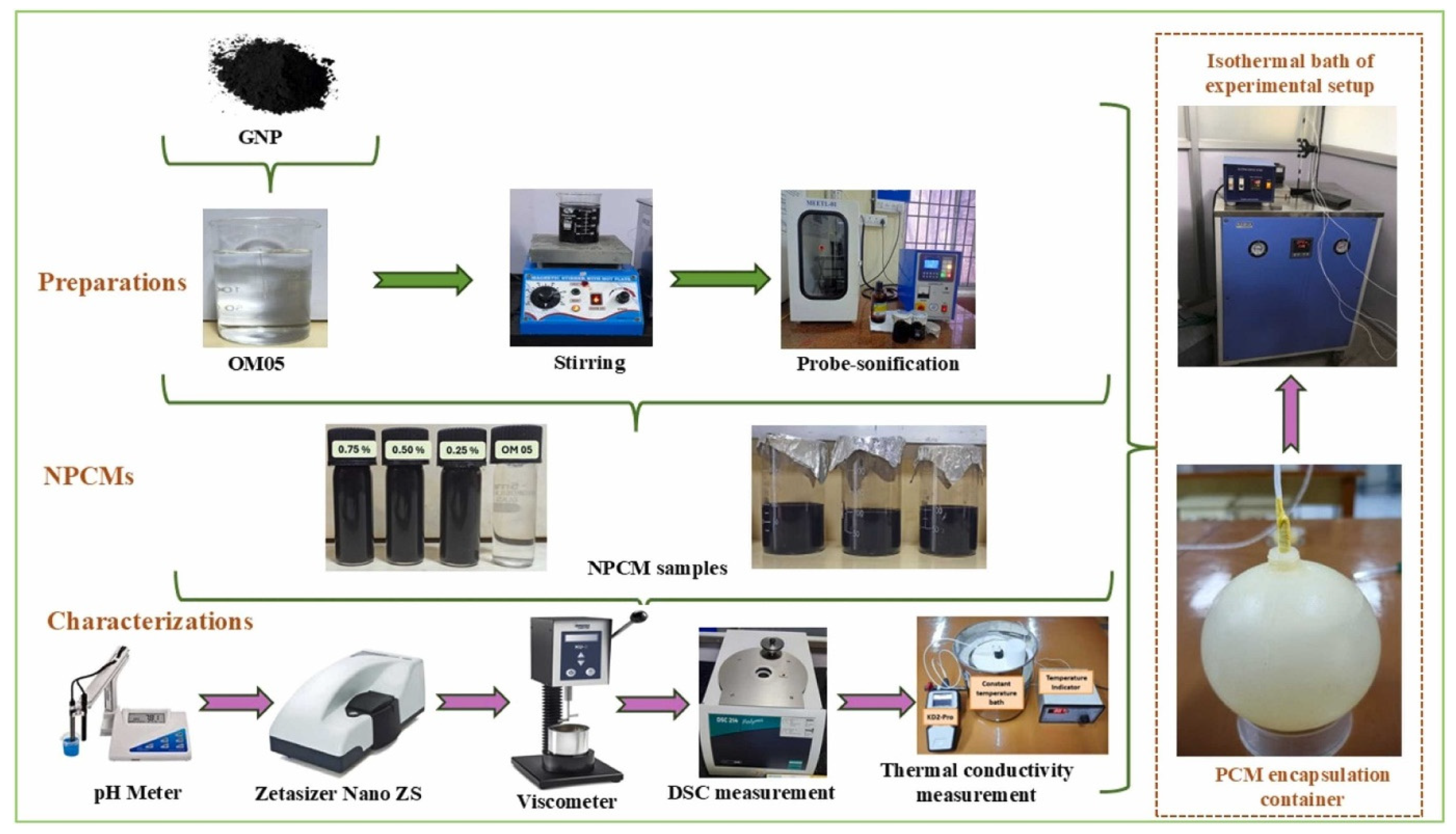
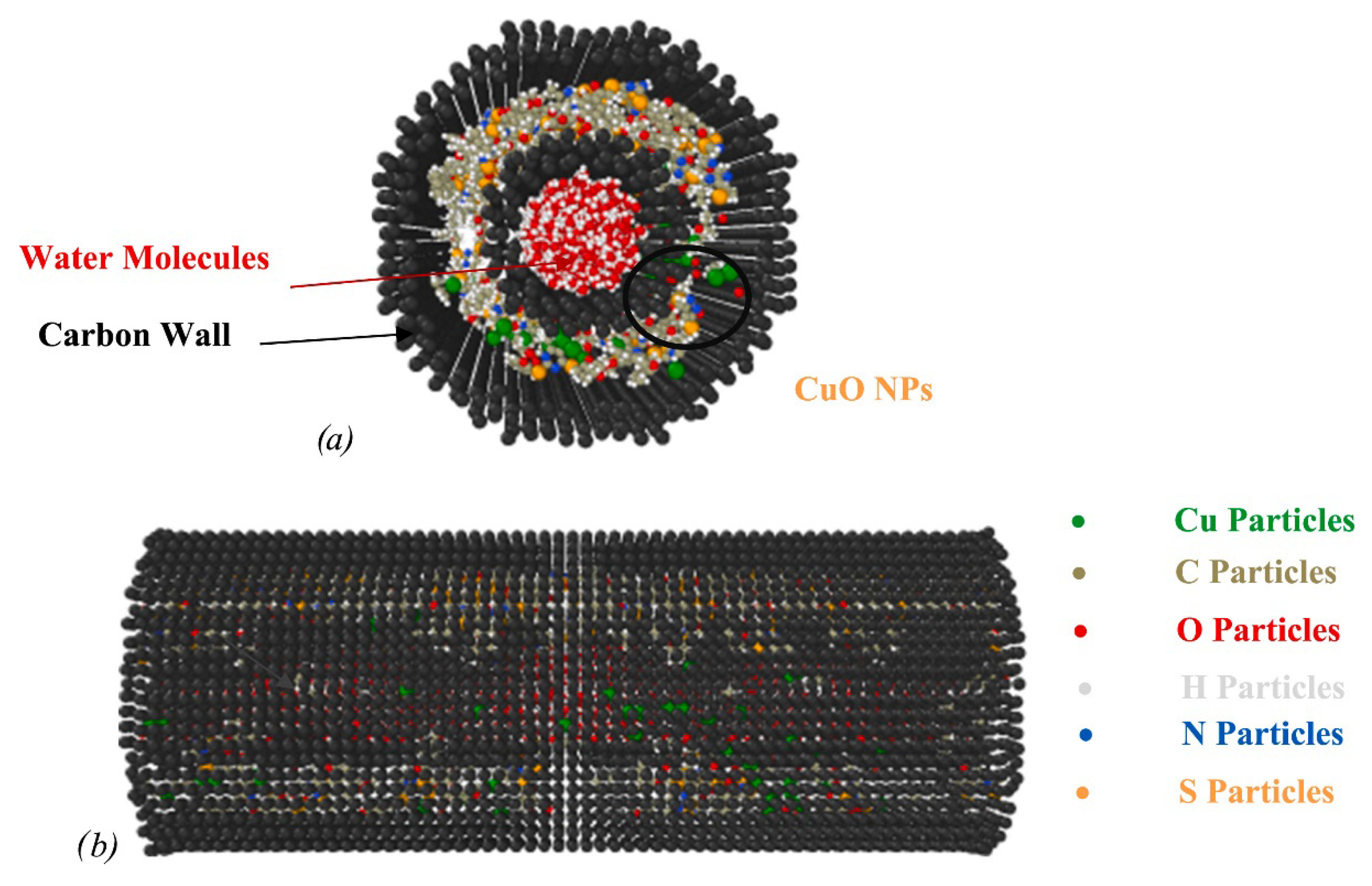
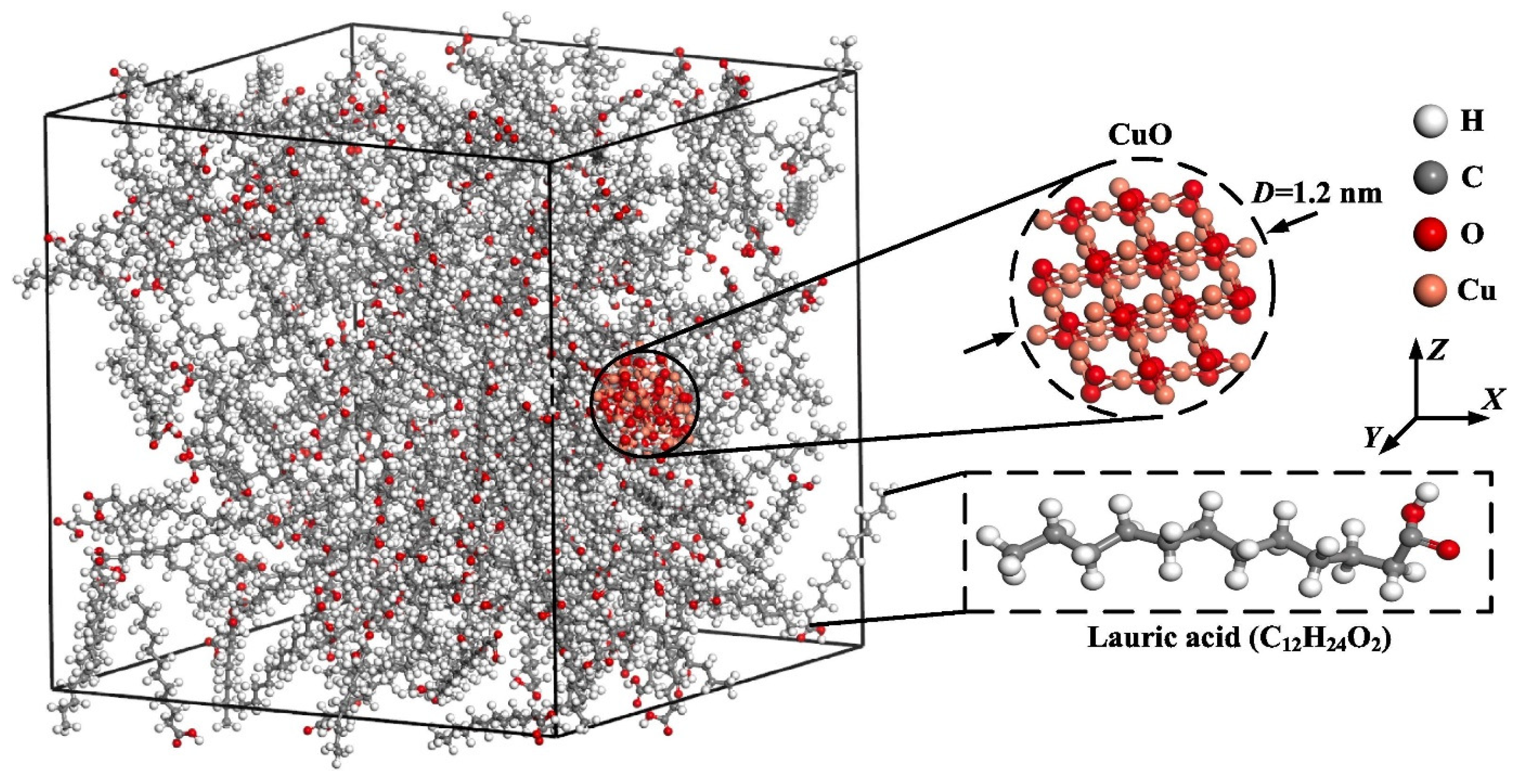
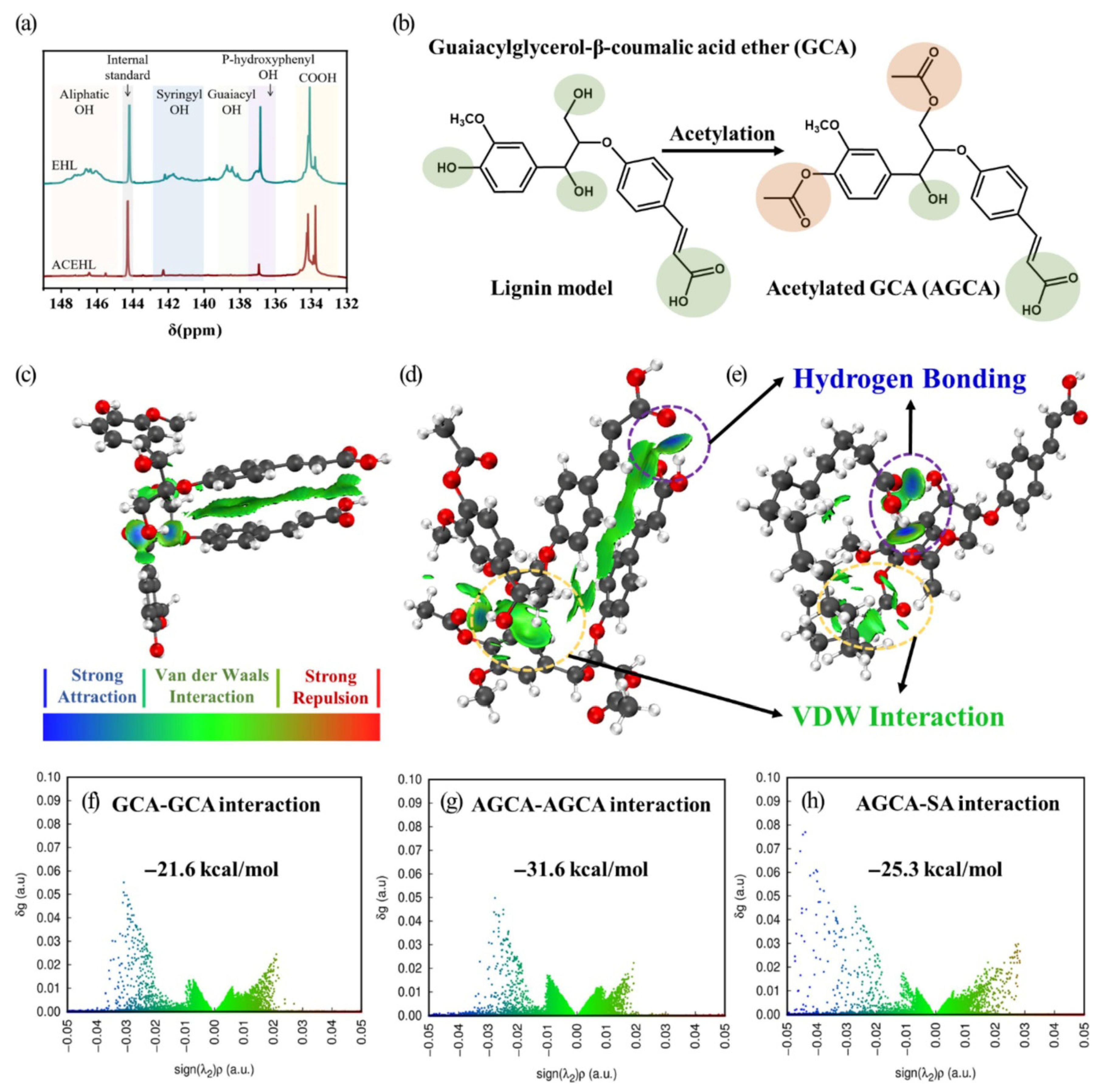
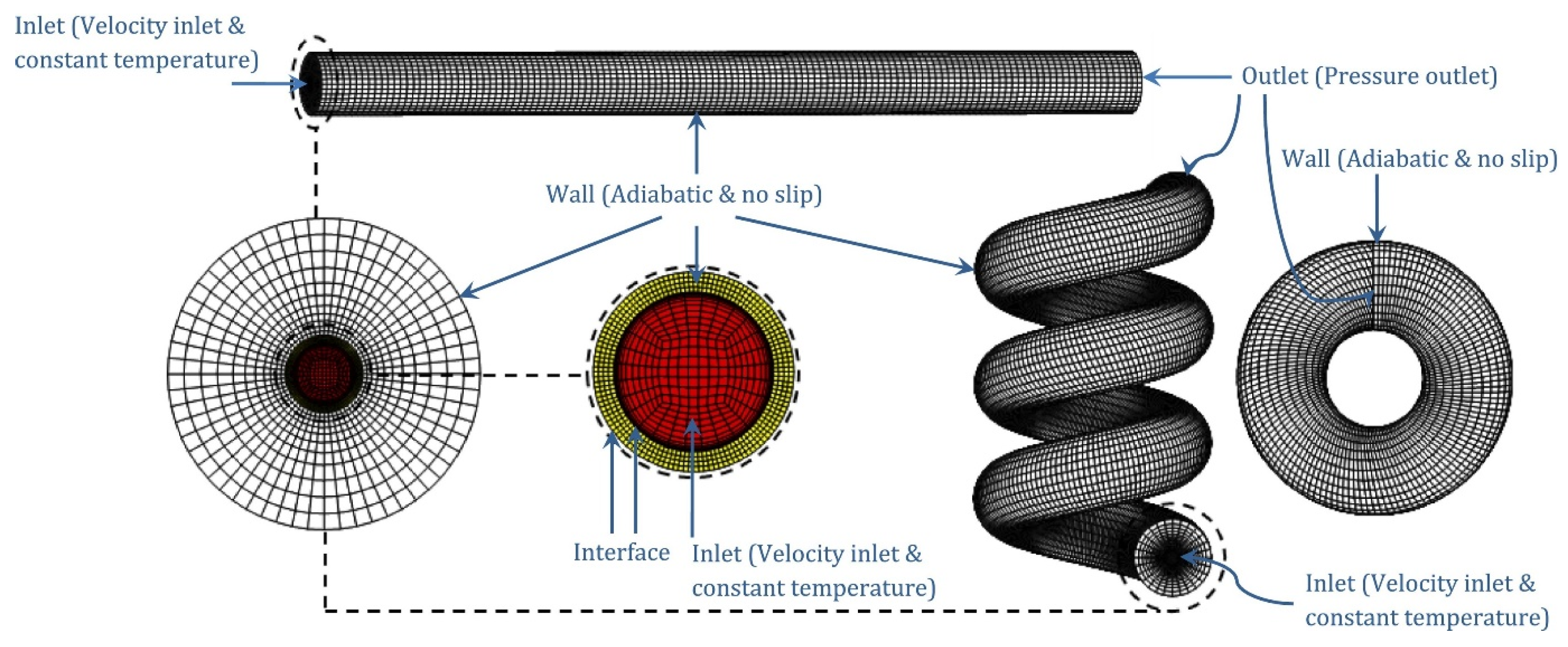
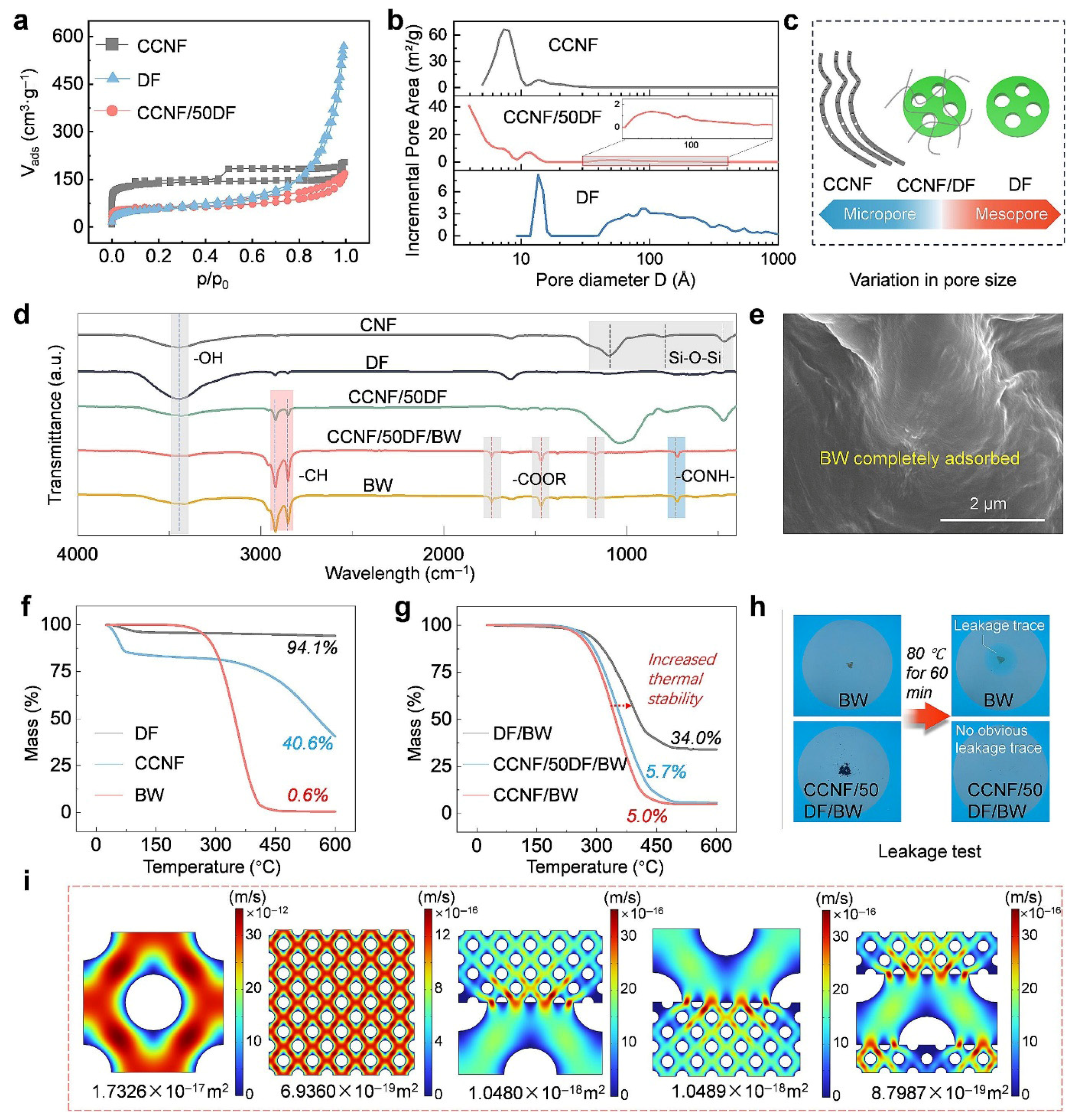
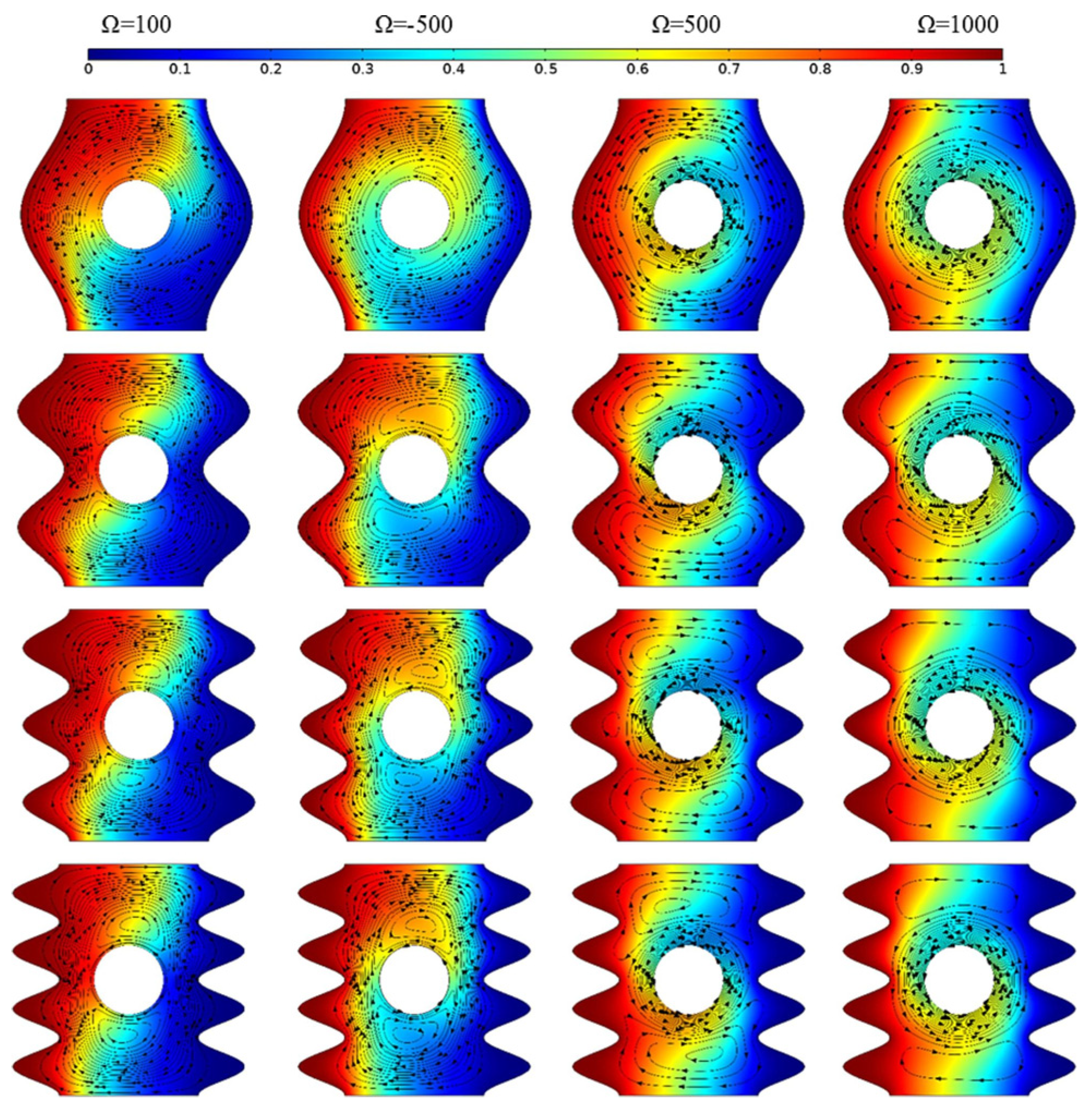

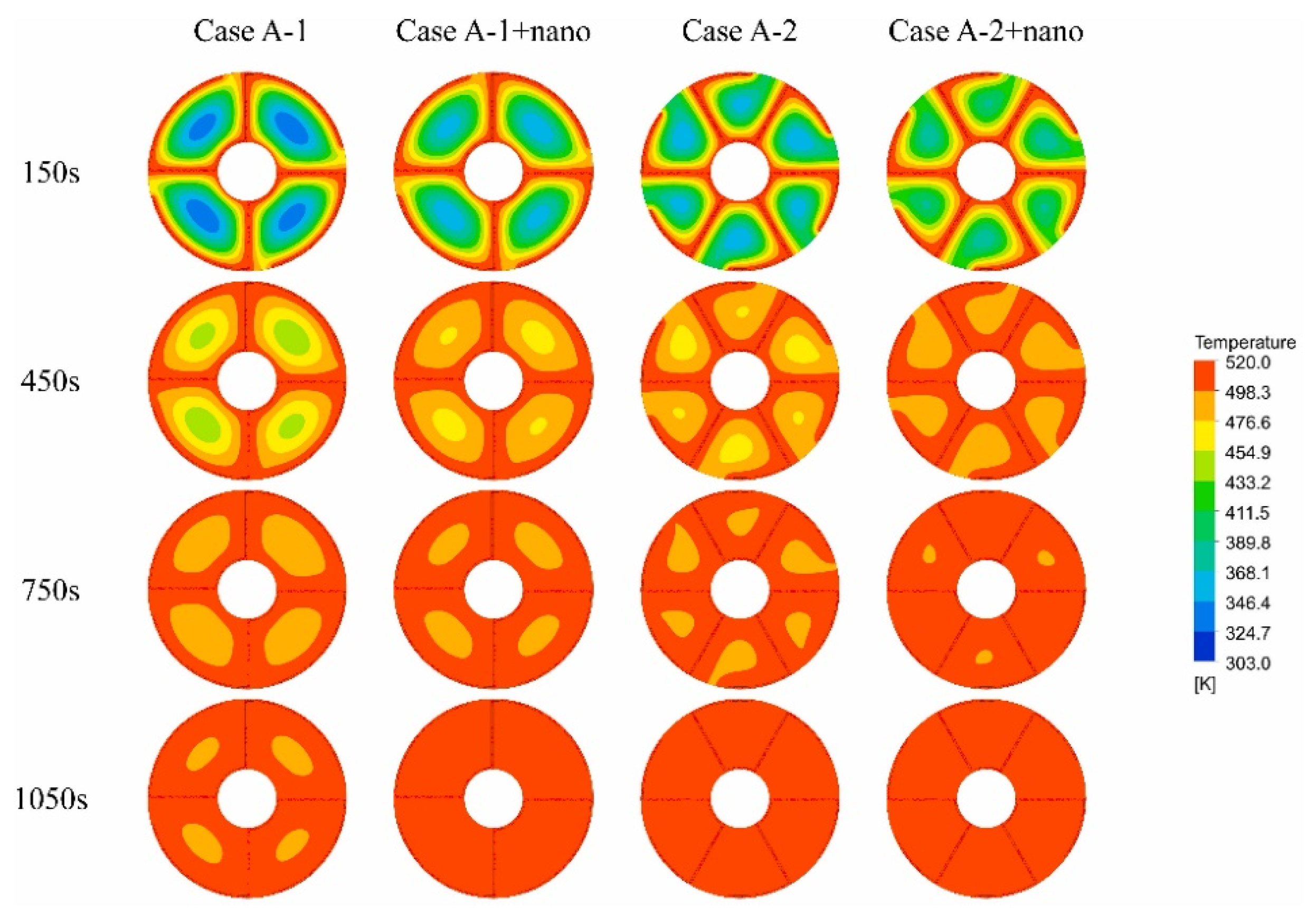

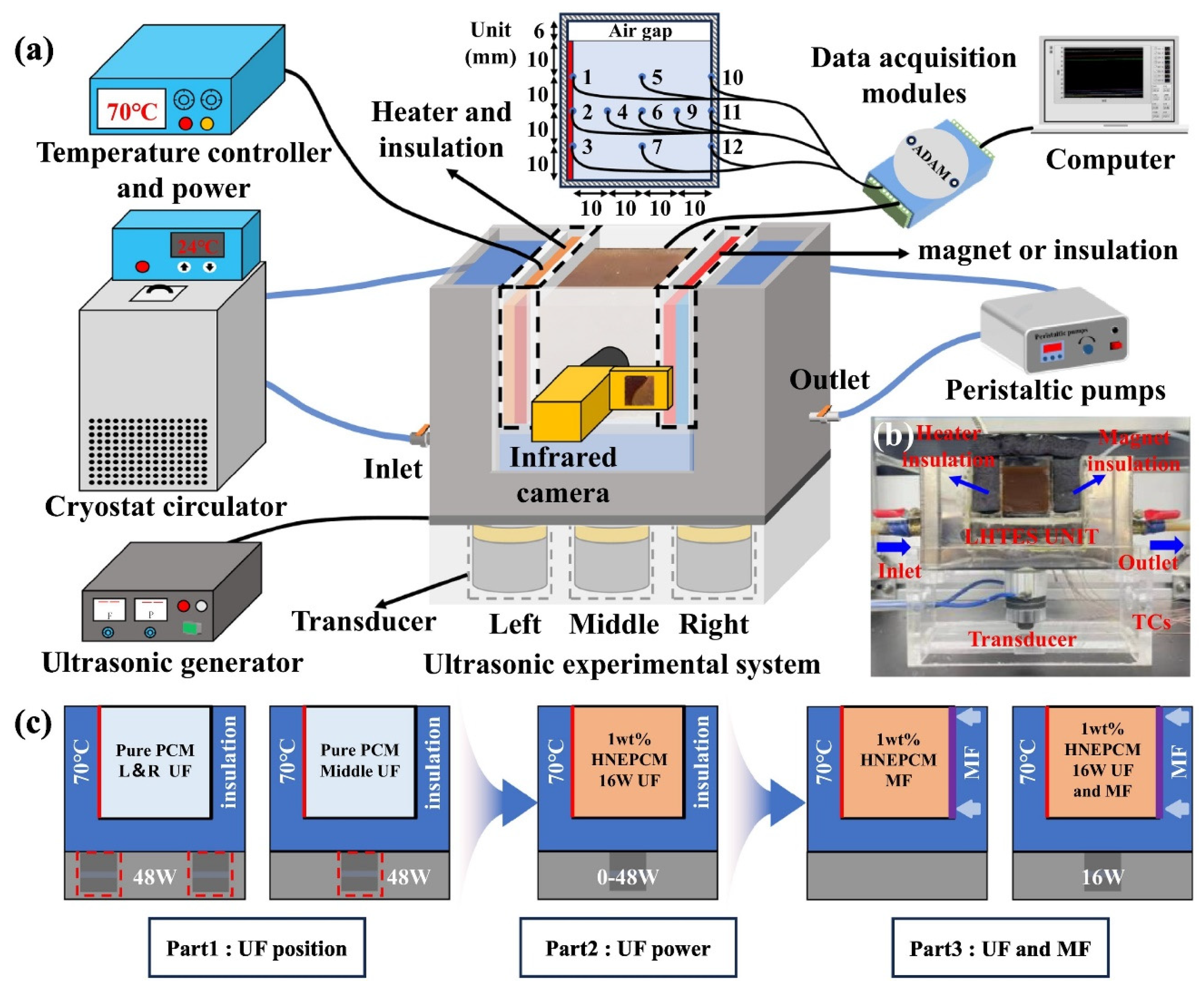

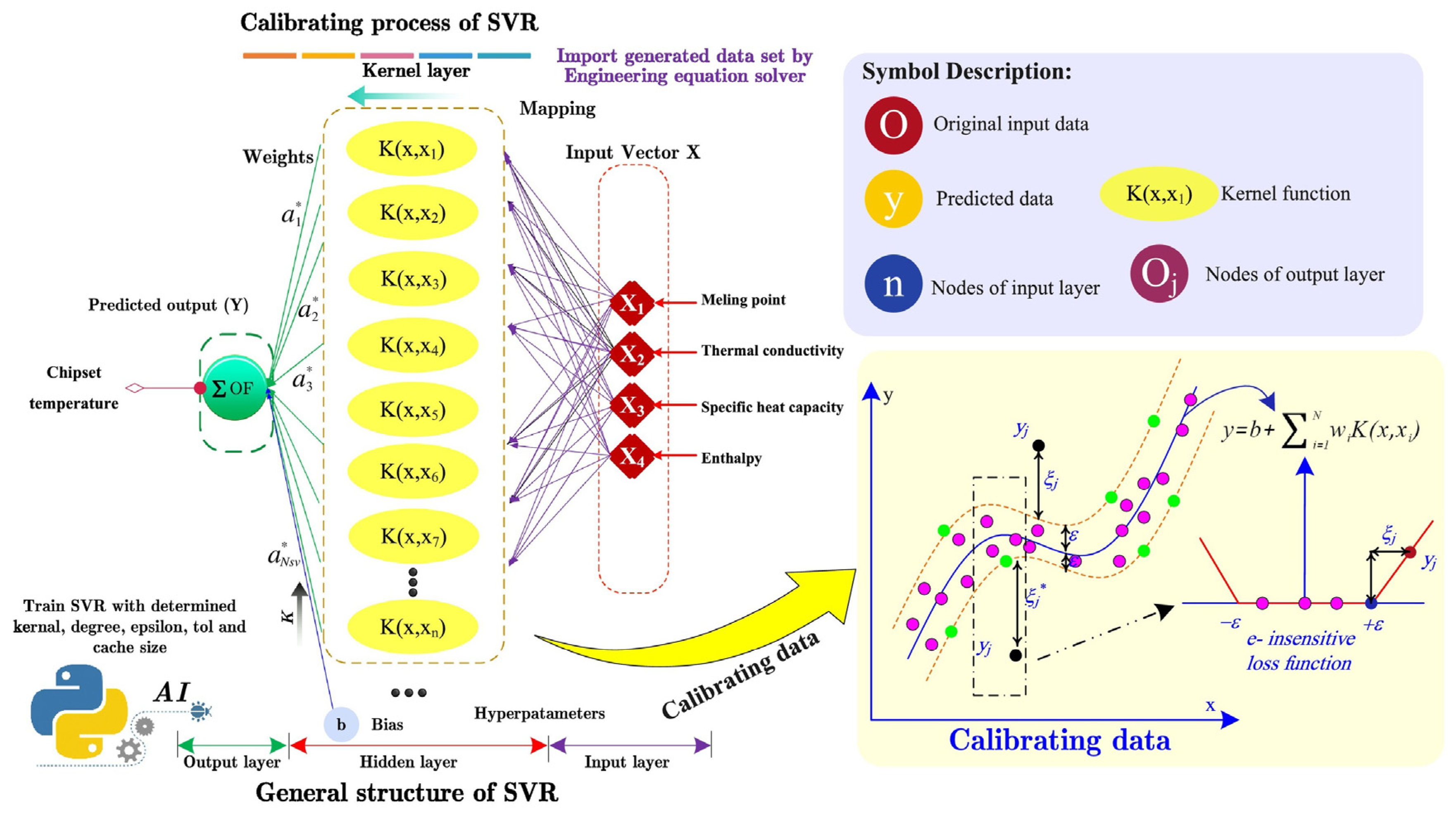
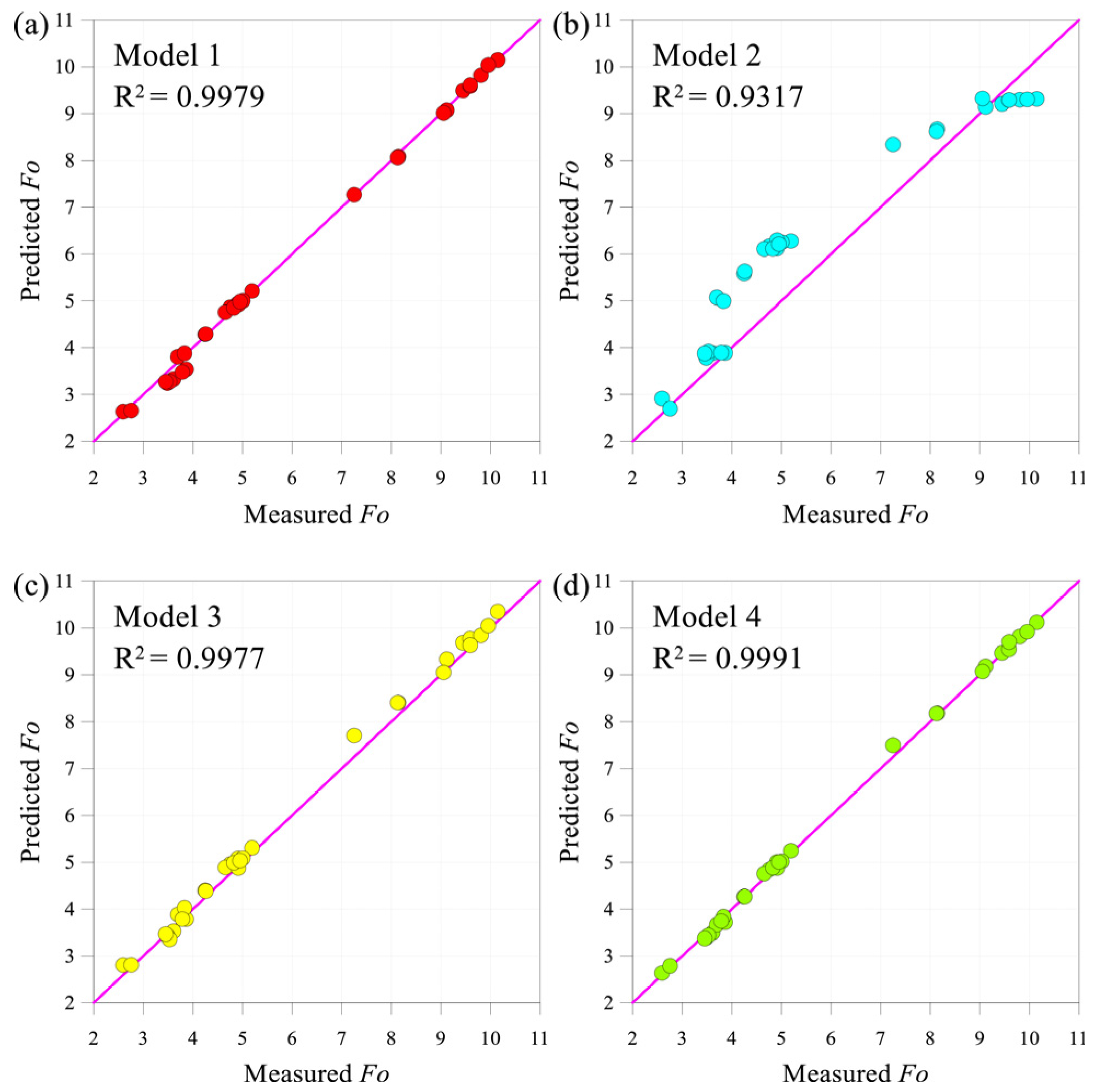
| PCM | Density of Solids | Density of Liquids | Specific Heat Capacity | Latent Heat | Thermal Conductivity (TC) | Temp. of Solids | Temp. of Liquids | Melting Temp. Range | Ref. |
|---|---|---|---|---|---|---|---|---|---|
| Unit | kg/m3 | kg/m3 | J/(kg·K) | kJ/kg | W/(m·K) | °C | °C | °C | |
| RT28 | 880 | 770 | 2000 | 179 | 0.2 | 25.98 | 29.6 | 3.63 | [15] |
| RT28HC | - | - | 2000 | 250 | 0.2 | 27 | 28 | - | [16] |
| RT35 | 860 | - | 2000 | 182 | 0.3 | - | - | 1.5 | [17] |
| RT42 | 880 | 760 | 2000 | 165 | 0.2 | - | - | 4 | [18] |
| RT50 | 876 | 710 | 2100 | 160 | 0.2 | - | - | 7 | [19] |
| RT55 | 880 | 770 | 2000 | 170 | 0.2 | 6 | [20] | ||
| RT58 | 840 | - | 2100 | 180 | 0.2 | 321 | 335 | [21] | |
| 60% NaNO3 + 40% KNO3 | 1980 | - | 1575 | 140 | 0.59 | 495 | 519 | - | [22] |
| 53% NaNO3 + 40%KNO3 + 7%NaNO2 | 1800 at 400 °C | - | 1500 at 400 °C | - | - | - | - | - | [23] |
| KNO3 | 2109 | - | 953 | 95 | 0.5 | - | - | - | [24] |
| Dodecyl sulfate | - | - | - | 200 | - | - | - | - | [25] |
| Lauric acid | 940 | 885 | 2285 | - | 0.15 | 40.48 | 42.48 | 2 | [26] |
| HS 29 | 1681 | 1530 | 1510 (S) 2620 (L) | 190 | 0.382 (L) 0.478 (S) | - | - | - | [27] |
| Coconut Oil | - | - | 2350 (S) 3230 (L) | 70–100 | - | - | - | - | [28] |
| Eicosane | 810 | 770 | 1900 (S) 2200 (L) | 241 | 0.4 (S) 0.157 (L) | - | - | - | [29] |
| C28H58 | - | 806 | - | 254 | - | - | - | - | [30] |
| Reference | Materials Set-Up | Analysis of Performance Improvement |
|---|---|---|
| Abdolahimoghadam et al. [39] | Graphene-Cu NPs are added to the bio-nano-based materials of coconut oil and beeswax. | The melting time of the four-tube system with 2 wt% Graphene-Cu hybrid NPs added is shortened by 80.25%, and the solidification time is shortened by 74.28%. |
| Kannan et al. [40] | CuO NPs are added to stearic acid. | The enhanced TC of NPCM with 0.5 wt% CuO NPs is 29.4% higher than that of pure PCM, and the congruent melting rate is increased by 31%. |
| Ahmed et al. [42] | SiC NPs are added to water to prepare nanofluids, and SiC NPs are added to paraffin to prepare NPCM. | When nanofluid with 0.6 vol% and NPCM with 1 vol% are added to the collector, the thermal efficiency improves by 86.2%, the electrical energy increases by 11.24%, and the maximum photovoltaic power output grows from 17.512 W to 26 W. |
| Maseer et al. [43] | 0.1% of Al2O3 NPs are introduced into water to prepare nanofluids. Subsequently, 0.65% of paraffin is introduced into the nanofluids to prepare NPCM. | The PVT system with NPCM coolant achieves a maximum power of 73.25 W, with a thermal efficiency of 70.5%, an electrical efficiency of 16.9% and a maximum overall efficiency of 84.23%. |
| Máñez-Espina et al. [44] | Ge, Ge2Sb2Te5, CaF2 | Energy coupling efficiency, energy efficiency, and unidirectional absorption asymmetry can all be improved. |
| Sathishkumar et al. [45] | 0.75% of GNP is added to OM to prepare NPCM. | TC of the cold-heat energy storage system has been significantly increased by 54%, and the total freezing time has been significantly reduced by 32%. |
| Baiju et al. [46] | Hydrated salt is prepared with 0.5 wt% GNP and 0.5 wt% nano-Al. | The charging time of the latent heat storage device that uses conical fins and NPCM in combination is shortened by 56%, and the annual life-cycle cost is 162.3 euros per year. |
| Wu et al. [47] | Binary alkane containing 5 wt% modified nano-Al2O3. | TC of NPCM with 5 wt% modified NPs is 0.31 W/m·K, and the melting time is reduced by 38.3%. |
| Shijina et al. [48] | Graphene flakes are affixed to polystyrene spherical balls encapsulated with a composite PCM of 80% paraffin and 20% octadecane, and then these are dispersed in an ethylene-glycol-water mixture to obtain nanofluid. | The subcooling degree of the coolant is reduced by 50%, and TC and viscosity of the nanofluid increase by 14.7% and 19%, respectively, and the heat capacity is increased by 56.7%. |
| Sivashankar et al. [49] | Organic PCM is prepared with 0.5 vol% GNP and OM35. | TC of the solid phase has increased by 93%, the conductivity of the liquid phase has increased by 78%, the thermal diffusivity of the solid phase has increased by 119%, the thermal diffusivity of the liquid phase has increased by 124%, the starting temperature has decreased to 31.21 °C, the peak temperature has decreased to 37.46 °C, the viscosity has increased by 76%, and the latent heat has increased by 19.82%. |
| Sutheesh et al. [50] | Tetradecan-1-ol serves as the PCM, while deionized water acts as the base fluid. The shell is constituted by polymethyl methacrylate, and MgO functions as the filling material. | The lowest Reynolds number during the highest cell discharge optimizes the phase transition of PCM. When the Reynolds number is 121.09 and the discharge rate is 5C, the convective HTC increases by 4.53 times and 6.15 times for 1% and 4% NPCM, respectively. |
| Liu et al. [53] | Pd–Se | Through regulating the thickness and the distance between electrodes on the apparatus, we bring about emerging phases. These phases display superconducting orders or can be manipulated to produce an ultralow resistance contact for 2D semiconductor transistors. Additionally, the phase engineering carried out on-device enables in-situ and customized synthesis of outstanding electrocatalysts, which has the ability to surpass the traditional modulation limit of composition proportion. |
| Zang et al. [54] | CuxS-Ag | Abundant active sites are furnished for improving the therapeutic activity by the dangling bonds on the amorphous CuxS surface. Moreover, through non-radiative relaxation, the amorphous state boosts the photothermal effect. |
| Yang et al. [55] | Bi-RuO2 | The Bi-RuO2 single-atom alloy oxide catalyst demonstrates a relatively low overpotential of 192 mV. It also shows excellent stability lasting over 650 h at a current density of 10 mA cm−2. These properties make possible a practical PEMWE which requires merely 1.59 V to achieve a current density of 1.0 A cm−2 under industrial conditions. |
| Reference | Materials Set-Up | Analysis of Performance Improvement |
|---|---|---|
| Karimipour et al. [59] | Cu/paraffin | TC and energy-efficiency transformation |
| Liu et al. [62] | Cu/paraffin | 7% Cu NPs: density, velocity, temperature, heat transfer flux, TC, charging time, discharging time |
| Singh et al. [63] | Cu/paraffin | 3% Cu NPs: density, velocity, temperature, heat transfer flux, TC, charging time, discharging time |
| Cao et al. [64] | hydrocarbon-water composite, and paraffin/platinum, Cu, and Al) | The combination of paraffin and Cu NPs exhibits the highest cost-performance ratio in terms of thermal performance |
| Huang et al. [65] | Cu, Sodium sulfate decahydrate | TC, radius, diffusion coefficient, phonon density of states, phonon resonance, Debye temperature |
| Gao et al. [66] | Silica aerogel (SA)/PCM/CuO | velocity, temperature, TC, and heat transfer flux |
| Yang et al. [67] | SA/paraffin/CuO | The concentration of Cuo NPs: density, maximum velocity, maximum temperature, heat transfer flux, TC, charging time, and discharging time |
| Ru et al. [68] | SA/paraffin/CuO | The radius of Cuo NPs: density, velocity, temperature, TC, charging time, discharging time |
| An et al. [69] | SA/paraffin/CuO | The charging time increased to 6.28 ns |
| Yu et al. [70] | CuO/lauric-acid | density, TC, and melting enthalpy |
| Fang et al. [71] | a mixture of Na2CO3 and K2CO3, SiO2 | Thermal conductivity, shear viscosity, test factors, temperature |
| References | Materials Set-Up/References | Research Methods | Research Points |
|---|---|---|---|
| Liang et al. [75] | Lignin fatty-acid capsules were prepared using an anti-solvent method after lignin was modified with a 6:4 ethanol-ethyl acetate mixture. | Characterization: Transmission electron microscope (TEM), Dynamic light scattering, Fourier transform infrared spectroscopy (FTIR), Nuclear magnetic resonance, X–ray photoelectron spectroscopy (XPS), Differential scanning calorimetry (DSC), Thermogravimetric analysis (TGA), DFT. Model: MD, Independent gradient model based on Hirshfeld Partitioning. | The solubility matching problem between lignin and stearic acid. The interaction relationship between lignin and stearic acid. A self-assembly mechanism for acetylated lignin and stearic acid. The heat storage performance, supercooling degree, and thermal stability of the modified lignin-stearic acid nanocapsules |
| Zhang et al. [76] | Octadecanol (ODA) is encapsulated into the hierarchically porous carbon structure infiltrated with Ni@graphite (Ni@C/C). | Characterization: SEM, nitrogen adsorption-desorption isotherm, TEM, Energy-Dispersive Spectroscop, X–ray diffraction, raman spectroscopy XPS, FTIR, TGA, DSC, UV-Vis-NIR spectroscopy, DFT. Models: Analytical method for phase change kinetics, MD, Zhishen Mo method, mean square displacement. | The crystallization characteristics of the PCM and Ni@C/C. The interaction energy, radius of gyration, kinetic energy, and diffusion coefficient between the PCM and Ni@C/C. The crystallization time and relative crystallinity of the pristine ODA and ODA/Ni@C/C. The non-isothermal charging and discharging performance, Localized Surface Plasmon Resonance effect, photothermal conversion ability, heat release characteristics, and extreme cold-heat management capacity of ODA/Ni@C/C-4. |
| Yao et al. [77] | The radio-frequency polymer framework (in-situ polymerized in the presence of a sodium hydroxide catalyst) and the phase change component (resorcinol (R) and furfural (F) are dissolved in molten phase change component). | Characterization: FTIR, SEM, Nitrogen adsorption-desorption isotherm, Brunauer–Emmett–Teller (BET), DSC, TC Test, Heat conductivity coefficient test, Leakage rate analysis, DFT, Flexural strength test, Temperature control test. | The adsorption effect between the RF framework and phase change component. Analyzed the mesoporous nanostructure characteristics of RF-PF. The mass retention rate, shape stability, TC, and contact thermal resistance of the RF- composite PCM specimens. The temperature and temperature difference of the RF- composite PCM plates |
| Tan et al. [78] | The composite PCM is prepared by using high-density carbon-nanofiber encapsulation of modified broad-leaved root starch enhanced with carbon nanofibers and graphene nanosheets and choosing sodium acetate trihydrate and sodium thiosulfate pentahydrate. | Characterization: DSC, SEM, X–ray diffractometer (XRD), TC analysis, Viscosity analysis, DFT. | The pore structure characteristics, interactions, solidification characteristics, crystallization characteristics, TC, melting enthalpy, and molecular structure features of the composite material. |
| Yuan et al. [79] | Tetradecanol is confined in the micro-mesopores of the MIL-101(Fe) nanoporous supporting matrix. | Characterization: BET, DFT, Porosity analysis, SEM, XRD, FTIR, DSC, TGA, Thermal cycling stability, Phase change loading rate test. | The interaction between MIL-101(Fe) and tetradecanol. The pore characteristics, adsorption characteristics, and crystallization characteristics of the composite PCM. The influence of different concentrations of tetradecanol on the phase change enthalpy transformation process of the composite material, weight loss rate and weight loss temperature, cycle stability, melting process characteristics, hydrothermal tolerance, and material loss degree. |
| Wang et al. [80] | Porous Zeolitic Imidazolate Framework-8 Microcrystal/Doxorubicin Hydrochloride @ Tetraol-Polydopamine Composite Material | Characterization: FTIR, TEM, XRD, SEM, Thermal infrared imaging, BET, DFT, Dynamic light scattering, Zeta potential analysis, Nanodrop one spectrophotometer | Drug release behaviors at different pH values and temperatures. The morphological characteristics, pore size characteristics, drug-loading capacity, and photothermal conversion ability of the composite material. |
| Zeng et al. [81] | Prepare C/Sb7Se3 thin film using Sb7Se3 and C materials. | Characterization: Magnetron sputtering instrument, XRD, Raman spectroscopy, near-infrared spectrophotometer, XPS, X–ray reflectometry, Atomic force microscope, Ion thinning process, Dual-beam focused ion beam process, TEM, Model: Utilize a signal system constructed from an arbitrary waveform generator, a digital source meter, and a micro-control probe observatory. Employ the Vienna ab initio simulation package, the projector-augmented wave potential, the generalized gradient approximation of Perdew–Burke–Ernzerhof, and DFT-D2. | Amorphous resistance characteristics, crystalline resistance characteristics, crystallization activation energy, crystallization process, grain size, interactions, and wide bandgap of the thin film |
| Xin et al. [82] | DHPD-VMTNS with both surface and confined space using Na2HPO4·12H2O. | Characterization: X–ray fluorescence, field emission scanning electron microscope, TEM, Atomic force microscopy, Zeta potential, XRD, FTIR, DSC, Constant-temperature water-bath method, TGA, DFT. Model: MD, optimization method of CASTEP software package, universal force field, analysis of electrostatic force and van der Waals force, Gamma analysis based on ultrasoft pseudopotential. | The interaction and diffusion mechanism between VMT and DHPD. The adsorption characteristics, crystallinity, compatibility, morphological features, phase change and heat storage properties of DHPD in VMTNS. |
| Research Method | Research Content | Ref. |
|---|---|---|
| SEM | Observe the surface morphology and microstructure of NPCM and assess its particle size and distribution. | [83,84] |
| TEM | Analyze the internal microstructure of NPCM and examine its crystalline structure and defects. | [85,86] |
| XRD | Identify the crystalline composition and crystallinity of NPCM and investigate its phase transition. | [87,88] |
| FTIR | Detect functional groups and chemical bonds in NPCM and investigate its chemical structure and interactions. | [89,90] |
| DSC | Analyze the thermal properties of NPCM, including thermal hysteresis, phase transition temperature, latent heat, and thermal stability. | [91,92] |
| TGA | Assess the thermal stability and decomposition temperature of NPCM and investigate its thermal decomposition process and composition. | [93,94] |
| T-history methods | Analyze the temperature curves of NPCM and research the thermophysical properties of the materials. | [95,96] |
| Reference | Materials Set-Up | Simulation | Analysis Method | Key Parameters |
|---|---|---|---|---|
| Gürsoy et al. [100] | RT58 paraffin, Al-based metal foam, nanoscale particles of Al2O3 | 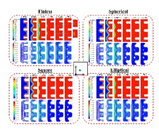 | Spherical, square and oval rectangular containers with integrated structural walls; Based on the finite volume method, the Brinkman–Forchheimer extended Darcy model and the local thermal equilibrium model, the enthalpy-porosity method. | Melting time, temperature difference, Nusselt (Nu), energy change, energy storage parameters. |
| Hekmat et al. [101] | RT-50, Al2O3 NPs | 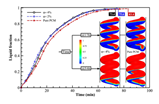 | Three-dimensional spiral circular structure; Enthalpy-porosity model and Boussinesq approximate. | Melting time, solidification time, volume fraction NPs, feed port temperature, Reynolds number. |
| Dora et al. [102] | Nano silica/coir, decanol-ethanol treated stripped vermiculite, concrete | 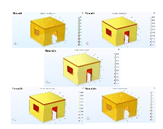 | 3D heat transfer building model; A general heat conduction equation for structures with no internal heat source. | TC, compressive strength, melting and freezing parameters, latent heat capacity, mass loss, compatibility and high heat resistance. |
| Yang et al. [103] | Cu foam/paraffin | 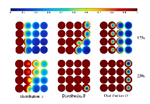 | Tetrahedral models of elements with different porosities, continuity equations, energy equations, heat transfer mechanisms. | Porosity uniformity, temperature difference, heat storage capacity. |
| Zhao et al. [104] | Cu foam, carbon fiber reinforced plastic composite and octadecane | 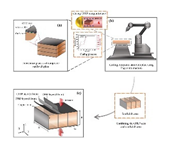 | A multifunctional thermal management composite sandwich structure: 3D failure model, universal testing machine, 2D transient numerical model. | Specific strength, specific energy, composite plate thickness, thermal rate, TC. |
| Sun et al. [105] | Artificially cultured diatom microlenses regulate carbocellulose nanofibers | 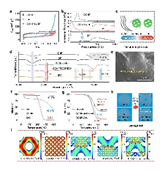 | Multi-level pore model, SEM, XPS, Al Kα radiation, Raman spectroscopy, N2 adsorption and desorption isotherms, BET, Barrett–Joyner–Halenda, FTIR, TGA | Shrinkage, specific surface area, enthalpy of phase- change, TC. |
| Çiçek et al. [56] | Fe3O4, MgO, ZnO, and xGNP, added to RT-35HC with volume fractions of 0.02, 0.04, and 0.06. Al6061 as a heat sink and fin material |  | A symmetrical 3D NPCM heat sink (114 × 114 × 25 mm) model was constructed using Ansys fluent to analyze the effect of the input heat flux generated by the heater cap (100 × 100 × 1 mm) with a grid and a duration of 900,000 and 1 s. Continuity momentum equation, energy equation, thermal conductivity equation, viscosity equation. | NP type, vessel temperature profile, melt profile, melting time and volume fraction, reference temperature, thermal conductivity, heat flux. |
| Saleh et al. [106] | Nano-capsules are structured with polyurethane as the outer shell and nonadecane as the inner core. | 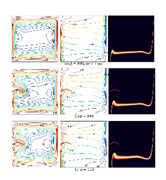 | The square cavity filled with nano—encapsulated PCM and a base fluid has a fin of variable length at the midpoint of its left side. The Arbitrary Lagrangian–Eulerian method, Boussinesq approximation, Laplace equation, and Winslow formula. | Rayleigh number, Stefan number, fusion temperature, Capsule PCM concentration, Melting temperature, Young’s modulus. |
| Egami et al. [107] | CuO nano-powders, PCM |  | A rectangular container with H-shaped fins. Galerkin Method. | Concentration and shape factor of nano-powders |
| Reference | Materials Set-Up | Simulation | Analysis Method | Key Parameters |
|---|---|---|---|---|
| Olivares-Robles et al. [110] | OM32 and Polyethylene glycol 1500, Al2O3 NPs | 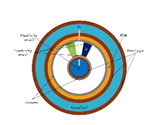 | The annular thermoelectric cooler model consists of p-type and n-type semiconductor components made of bismuth telluride (Bi2Te3), with the components insulated by a ceramic plate and cooled using PCM. Finite difference method discrete transient equations | Coefficient of performance, TC, Reynolds number, Prandtl number, Nu, NP concentration |
| Benyahia et al. [111] | Paraffin, Cu NP | 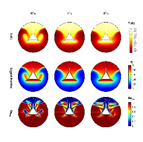 | The cylindrical shell of the inner hollow triangular tube was established; the two-dimensional axisymmetric formula was used to simulate the thermal and flow behavior in the latent heat thermal energy storage (LHTES) element, the numerical solution was obtained by the generalized α time integral method, the second-order Lagrangian finite element was spatially discretized with a time step of 1 s, Boussinesq approximate, the Carman–Kozeny relation kinetic energy equation, and the Carman–Kozeny equation | The concentration of Cu NPs, TC, melting time, inclination angles, Nu, eccentricity, porosity |
| Bouzennada et al. [112] | Polyurethane/Nonadecane dispersed in water |  | A 2D enclosed body filled with NPCM fluid; Galerkin weighted residual finite element method, Galkin weighted residual finite element method | Volume fraction, cylindrical radius, rotational speed, melting temperature, flow structure, heat transfer rate, Stefan number, Nu |
| Gholami et al. [113] | Na2SO4·10H2O was mixed with Al2O3 and MgO NPs, paraffin and eicosane | 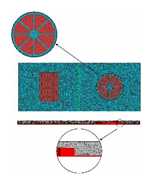 | A photovoltaic panel and PCM cavity structure were established; A first-order upwind approach for the discretization of the momentum equation and a second-order approach for the energy equation, and a second-order scheme for the energy equation | the concentration of NPs, efficiency and temperature |
| Nandi et al. [114] | CuO NPs, lauric acid, RT-35HC and P-58 | 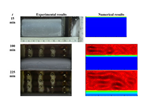 | a rectangular geometry characterized by specific dimensions | The concentration of NPs, fin structure, energy storage rate, melting rate |
| Shaik et al. [115] | CuO NPs, RT82 | 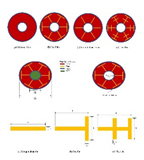 | PISO method, PRESTO, second-order upwind methods, second-order upwind algorithms | NP concentration, shape, melting time, melting speed |
| Waqas et al. [116] | MWCNT, TiO2, molten-salt PCM |  | Boussinesq approximation, Semi-implicit method for pressure linked equations (SIMPLE), PRESTO system | Fin shape, compactness, melting time |
| Mahdavi et al. [117] | Cu NPs, porous Cu media, and RT35-HC paraffin | 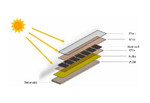 | Five-layer PV panels; discrete ordinate method; Boussinesq approximation | Electrical efficiency, economic analysis, pipe placement, NP concentration |
| Alam et al. [118] | n-Octadecane, Capric acid, MWCNTs, Cu metal foam | 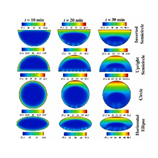 | A two-dimensional computational model of square geometry, finite volume method | Enclosure geometries, Prandtl numbers, Grashof number, Stefan number, NPs concentration, melting rate |
| Kiyak et al. [119] | CuO NPs, RT19HC | 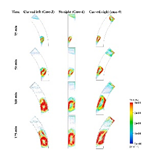 | a curved geometry and a straight geometry; the Navier–Stokes equations, enthalpy-porosity technique. Boussinesq approximation, finite volume method, SIMPLE, the implicit Euler method | Nu, concentration of NPs, geometric curvature, phase change time, melting time, discharge efficiency |
| Reference | Materials | System | Devices | Key Parameters |
|---|---|---|---|---|
| Amin et al. [120] | Graphene, beeswax | Freshwater production | Distillation tubes, K type thermocouples, insolation intensity meters, graduated cylinder connections, data acquisition equipment | Ambient temperature, solar radiation, thermal conductivity, temperature, freshwater productivity, thermal efficiency, energy efficiency |
| Singh et al. [121] | Al2O3, OM37 | Solar ponds | Data collectors, thermocouples, solar pond installations | Latent calorific value, thermal conductivity, thermal power, thermal efficiency |
| Emara et al. [122] | TiO2, Al2O3, paraffin | Distilled water | Radiators, water tanks and their heaters, liquid supply tanks, centrifugal pumps, fans, flow meters, thermocouples, temperature sensors, temperature indicators, solid state relays | Flow rate, rotational speed, heat transfer coefficient, NP concentration |
| Al-Karboly et al. [123] | SiC, PCM | PV | Solar simulator, pyranometer, I-V checker, Laptop, datataker, digital flow meter, pump, fluid tank, water chiller, RTD sensors, Themocouples | Electrical efficiency, thermal efficiency, overall efficiency, nanofluid concentration |
| Kamrava et al. [124] | ZnO, CuO, Al2O3, paraffin | Underfloor heating | A structured framework for integrating NPCMs | NP concentration, floor temperature, heat flux, thermal conductivity, melting time |
| Gür et al. [125] | B4C, RT35HC | radiator | PVT collectors, heat sinks, PCM layers, Cu tubes | Water temperature, room temperature, heat retention |
| Sathishkumar et al. [126] | GNP, strong nitric acid | energy storage tank | A chiller unit, energy storage tank, circulating pump, flow meter and energy meter | Flow rate, desolidification time, charging time, melting time, heat transfer rate, temperature, charging power, voltage drop, latent heat energy, accumulated energy, specific energy consumption |
| Bassam et al. [127,128] | SiC, paraffin, Polyvinylpyrrolidone | PV | Fluid tank, pump, flow meter, data logger, photovoltaic panel, pyranometer, I–V curve checker, computer cooling unit, heat exchanger, PCM expansion tank | Electrical efficiency, thermal efficiency, temperature |
| Kibria et al. [129] | Al2O3, ZnO, paraffin, | PV | PV, hot water storage, PVT/PCM, Structure, PVT/HNPCM, water tap, overhead tank, pipes | Thermal conductivity, latent heat capacity, temperature, electricity efficiency |
| Bharathiraja et al. [130] | MWCNTs, SiO | Collector | Cup type anemometer, data logger, solar intensity meter, laptop, storage tank, copper tube embedded PCM, thermocouple, absorber plate | Outlet water temperature, temperature, hot water time |
| Reference | Materials | Physical Model | Initial and Boundary Conditions | Governing Equations | Approach | Key Parameters |
|---|---|---|---|---|---|---|
| Izadi et al. [132] | Al2O3, paraffin | Ahexagonal heat storage unit | Continuity, momentum in two coordinate directions and energy equations | The enthalpy- porosity method, the finite element method | The tilted angle and intensity of the magnetic field, the Hartmann number, Nu, the nanoadditives concentration | |
| Hassan et al. [133] | Shell-core structured particles suspended in water | A U-shaped baffled cavity | Continuity, momentum conservation with additional source terms, and energy balance | The Arbitrary Lagrangian–Eulerian approach, the deformation gradient tensor and the second Piola–Kirchhoff stress tensor | Rayleigh number, Stefan number, fusion temperature, NP volume fraction, oscillation amplitude, Young’s modulus, Hartmann number, the variable time | |
| Younis et al. [134] | A graphene core encapsulated by a polyurethane shell | A prism cover drive chamber | Continuity, momentum conservation, and energy balance | Galerkin method, Boussinesq approximation | Reynolds number, Darcy number, Darcy number, the angle of deflection | |
| Selimefendigil et al. [135] | Water-Ag-MgO hybrid NF | A triangular shape | - | Continuity, momentum conservation, and energy balance | Kozeny–Carmen model, method, the finite element method, Streamline Upwind Petrov–Galerkin approach, Biconjugate Gradient Stabilized | Port size, Reynolds number, Reynolds number. |
| Selimefendigil et al. [136] | Ag-MgO, paraffin | Multi jet impingement system | - | Energy equation, conservation equation. | finite element method, Lagrange FEs of various orders, SUPG, BICGStab. Kozeny–Carmen method | Nu, Reynolds number, magnetic field strength and inclination |
| Selimefendigil et al. [137] | Spherical Al2O3, cylindrical MWCNT, platelet GNP | Trapezoidal vented cavity | Continuity, momentum conservation, and energy balance | Kozeny–Carman model, Galerkin weighted residual finite element method | Reynolds number, Hartmann number, inclination parameter, non-uniform amplitude, NP loading. | |
| Nguyen et al. [138] | Al2O3, paraffin | A closed fined rectangular chamber | Continuity, momentum conservation, and energy balance | The effective thermal conductivity of ferromagnetic-PCM, Boussinesq approximation | Capsule location, Hartmann number, | |
| Lu et al. [139] | Fe3O4, paraffin | a glass beaker filled with PCM | - | - | uncertainty analysis | NP mass fraction, magnetic field rotational speed |
| Li et al. [140] | Al2O3, Fe3O4 acetylacetone | Ultrasonic experimental system | - | - | SEM, EDS, uncertainty analysis | Nu, filling height, melting time, melting rate |
| Zhuang et al. [141] | Al2O3, paraffin | A set of visualized experimental systems based on thermochromic liquid crystal (TLC) | - | - | TLC, GetData software Version 2.26, uncertainty analysis | Nu, filling height, melting time, melting rate |
| Farahani et al. [142] | RT82, Fe3O4. | Annular structure with strip fins | - | Continuity, momentum conservation, and energy balance | SIMPLE algorithm, center difference and quick method | Uniform magnetic field pattern, fin effect, melting time, NPs concentration. |
| Reference | Materials | Model | A pproach | Input | Output | Mean Absolute Percentage Error |
|---|---|---|---|---|---|---|
| Shakibi et al. [146] | MWCNT/PCM | ANN | CFD, LSTM, Extreme Learning Machine, Radial basis function, MLP, GWO, bat algorithm (BA), optimization based on biogeography (BBO), PSO, TOPSIS, LINMAP, and Shannon entropy | Surface temperature, coolant outlet temperature, electrical efficiency, thermal performance, melted PCM | Surface temperature, coolant outlet temperature, electrical efficiency, thermal performance, melted PCM | PSO: 0.09714; BBO: 0.07890; GWO: 0.07800; BA: 0.07837 |
| Aly et al. [147] | PMMA, n-octadecane, water | XGBoost | the least squares boosting method | Nu, Sherwood number | Nu, Sherwood number (SH) | Nu: 5 × 10−7; SH: 2.1 × 10−7 |
| Abdolahimoghadam et al. [148] | Beeswax, coconut oil, Gr-Cu hybrid NPs | MLP-ANN | Tansig, radbas | Temperatures, concentrations, thermal conductivity, liquid or solid state of PCM, latent heat of melting and solidification processes | Latent heat, thermal conductivity |
TC: 1.1253 × 10−4 Latent heat: 4.7 × 10−4 |
| Abdolahimoghadam et al. [149] | Beeswax, coconut oil, Gr-Cu hybrid NPs | MLP-ANN | Trainlm, trainbr, tansig, radbas, logsig | Concentration, density, average temperature, specific heat, viscosity, latent heat, thermal conductivity | The melting’s and solidification’s liquid fraction and time, | Solidification: 6.1019 × 10−7, 0.0458; Melting: 8.05 × 10−5, 0.00935 |
| Gao et al. [150] | MWCNT, GNPs, nano-graphite (NG), myristic acid (MA) | Automatic correlation determination; k nearest neighbors and polynomial regression; Minimum absolute shrink and selection operators | - | Solid-state thermal conductivity; thermal conductivity of pure myristic acid, temperature; Melting-state latent heat | Liquid-state thermal conductivity; thermal conductivity of NPCMs; Freezing-state latent heat | GNPs/MA: 1.762 × 10−4; MWCNTs/MA: 5.45 × 10−7; NG/MA: 5.035 × 10−6 |
| Ghasemi et al. [151] | Al, microencapsulated PCM-37 | ANN | Levenberg-Marquardt, sigmoid, backpropagation algorithm, Regularization techniques | Heat flux, Reynolds number, concentration | Performance evaluation criterion, average Nu | - |
| Kiaghadi et al. [152] | RT44HC, Silver | Auto-regressive integrated moving average | Linear regression, lasso regression, polynomial regression | Time | Liquid fraction | 0.0093 |
| Kiaghadi et al. [153] | RT28HC, Cu | Auto-regressive integrated moving average | Linear regression, lasso regression, polynomial regression | Time, temperature of PV, melting fraction, temperature of NPCM, electrical efficiency | Time, temperature of PV, melting fraction, temperature of NPCM, electrical efficiency | - |
| Yang et al. [154] | LiFeO4, n-nonadecane | ANN | ReLU | Reynolds number, porosity of nickel foam | Maximum temperature | - |
| Xu et al. [155] | sodium lauryl sulfate, n-eicosane | ANN | Gradient descent algorithm | Shear rate and mass fraction | Dynamic viscosity, density, shear stress | 0.00066 |
| Salari et al. [156] | MWCNT, RT-35 HC, RT-47 | Harris Hawks optimizer | Random forest | - | The temperature of PCB | - |
| Khadem et al. [157] | RT-35 HC, aluminum foam | Support vector regression with hybrid | GWO |
Meling point,
thermal conductivity, specific heat capacity, enthalpy |
Chipset
temperature | - |
| Fini et al. [158] | n-Octadecane, Polymethyl methacrylate | ANN-multiobjective genetic algorithm | NSGA-II, LINMAP, TOPIS, Shannon Entropy | Reynolds number, volume fraction | Nu, pressure drop | - |
| Ref. | Materials Set-Up | Analysis Method |
|---|---|---|
| Alazwari et al. [161] | Highly conductive nanomaterials dispersed in D-mannitol can be utilized to enhance heat transfer in LHTES systems | The Bayesian method optimized by Markov chain Monte Carlo is implemented. Independent variables (normally distributed): TC, density, specific heat capacity of the thermophysical properties of NPCM, as well as Reynolds number and inlet temperature of the inlet conditions of the heat conducting fluid. Dependent variable: Fo. Data analysis: Four models are established with 153 input-output CFD data. The ratio of the training set to the test set is 8:2. Mean Squared Error, Root Mean Squared Error, and Coefficient of Determination (R2) are used to analyze the accuracy of the model’s predicted values. A model that can best predict the Fo of the actual dataset is established to predict the dimensionless melting time. |
| Goodarzi et al. [162] | Graphite nanosheets reinforcing dodecanol (C12H26O) | The Bayesian method optimized by Markov Chain Monte Carlo is implemented. Independent variables (normally distributed or log-normally distributed): Melting rate and surface-average Nu. Dependent variables: The Stefan number, which is the ratio of sensible heat to latent heat and represents the driving force for melting. The Grashof number indicates the intensity of natural convection of liquid PCM during the melting process. Finally, the Fo represents the dimensionless time in transient problems. The model that can best predict the dataset values was analyzed. Another model that can best predict the Nu values was analyzed. Data analysis: Five models are established, using 573 melting-rate datasets and 516 surface-average Nu-number datasets. The ratio of the training set to the test set is 7:3. The mean, the standard deviation of the number of iterations, and the standard deviation are used for precise data analysis. The coefficient of determination, root-mean-squared error, and mean-squared error are used to evaluate the accuracy of the predicted values of the proposed models. |
| Reference | Materials | System | Parameters | Total Uncertainty (%) |
|---|---|---|---|---|
| Al-Aasam et al. [165] | SiC, paraffin | PVT | Temperature, mass glow rate, solar irradiance, voltage and current | 3.83 |
| Daneshazarian et al. [166] | Ag, Cu, Al2O3, CuO, TiO2, GNP, MWCNT, paraffin | Ground source heat pump | Temperature outlet, temperature inlet, flow rate | 0.5 |
| Gür et al. [167] | Y2O3, myristic acid | Electronics | The temperatures of PCM, the temperatures of empty system | 1.5 |
| Venkatesh et al. [168] | SiC, Ag, paraffin | Heat exchanger | Radiation, temperature, wind velocity, flow rate | - |
| GaneshKumar et al. [169] | Al2O3, paraffin | Solar air heater | Mass flow rate; Nu; CHTC; heat gain; solar energy; energy efficiency | ±2.5; ±3.9; ±4.1; ±4.32; ±5.45; ±4.21 |
| Amin et al. [120] | Graphene, beeswax | Freshwater production | Intensity of solar radiation, temperature, productivity | ±2; ±0.1; ±5 |
| Singh et al. [121] | Al2O3, OM-37 | Solar ponds | Magnetic stirrer, weight of NP and PCM, thermal analysis in DSC, hot disk thermal constants analyzer, solar intensity, wind speed, temperature | 2.59 |
| Al-Karboly et al. [123] | SiC | PV | temperature, mass flow rate, solar irradiance, voltage and current. | 3.82 |
| Bassam et al. [127,128] | SiC, paraffin | PV | Temperature, radiation, voltage, flow | ±0.1; ±1.5; ±1.0; ±0.5 |
| System | Product | Unit Production Cost | Life Cycle Cost | Payback Period | CO2 Reduction | Ref. |
|---|---|---|---|---|---|---|
| Solar still | Distilled water | 0.0115 $/L | 130 $ | - | 1.57 ton/year | [176] |
| Solar still | Distilled water | 0.09 $/L | 219 $ | 496 days | 16.80 ton/payback period | [177] |
| Battery | Flow condition | - | 49–70 $ | - | - | [178] |
| Collector | Electrical energy | 0.0138 €/kWh | 3.6624 € | 0.058 year | - | [179] |
| Solar still/PVT | Distilled water; electrical energy | 0.01495 $/L | - | 7.263 year; 0.26 year | 3322.12 kg (emissions), 564.82 kg (mitigation); 6.98 ton/payback period | [180] |
| Solar still | Distilled water | 0.012 $/L | - | 129 days | - | [181] |
| Solar still | Distilled water | 0.0192 $/L | - | 7.26 year | 322.12 kg (emissions); 565 kg (mitigation) | [182] |
| PVT | Electrical energy | 0.134 $/kWh | - | - | - | [183] |
| Solar still | Distilled water | 0.011 $/L | - | - | - | [184] |
| Solar still | Distilled water | - | - | - | 448 kg/m2 year | [185] |
| Solar still | Distilled water | 0.01 $/L | 420 days | 28.8 ton/year | [186] | |
| Solar still | Distilled water | 0.00713 $/L | 65.85$ | - | - | [187] |
| Solar still | Distilled water | 0.0156 $/L (in summer), 0.0264 $/L (in winter) | - | - | 16.38 ton/year (in summer), 19.47 ton/year (in winter) | [188] |
| Policy/Legislation Name | Country/Region | Effective/Revised Date | Core Content | Ref. |
|---|---|---|---|---|
| New Collective Quantified Goal on Climate Finance | UN (COP29) | Nov 2024 | Requires developed countries to provide $300 billion in public funding annually by 2035, mobilizing $1.3 trillion annually to support developing countries. | [189] |
| - | UN (COP30) | - | A carbon tariff revenue-sharing and deforestation accountability mechanism; Biofuel production and mineral extraction do not sacrifice the ecological rights of developing countries. | [190] |
| Strategies for Affordable and Fair Clean Energy Transitions | IEA | May 2024 | Argues clean energy costs less than fossil fuels; proposes energy efficiency subsidies, promotion of efficient appliances, and clean transport. | [191] |
| 2023 Energy Efficiency Report | IEA | Nov 2023 | Requires doubling the global annual energy efficiency improvement rate to 4% by 2030. | [192] |
| Renewable Energy Capacity Tripling Goal | IEA/IRENA | 2023–2025 (Progress) | Global renewable energy capacity to reach 11.2 TW by 2030; 585 GW added in 2024 (China accounted for 64%). | [193] |
| Net Zero Industry Act | EU | 2025 (Implementation) | Local net-zero tech production capacity ≥40% by 2030; limits dependence on any single third country to >50%. | [194] |
| Batteries and Waste Batteries Regulation | EU | Feb 2025 | Mandates disclosure of full-lifecycle carbon footprint for batteries; implements “battery passport” from 2027. | [195] |
| Carbon Border Adjustment Mechanism | EU | 1 January 2025 | Full carbon tax implementation on imports across six sectors (steel, Al, etc.). | [196] |
| Critical Raw Materials Act | EU | 2023 (Adopted) | By 2030: 10% domestic extraction, 40% domestic processing, and 25% domestic recycling capacity for strategic raw materials. | [197] |
| European Wind Power Action Plan | EU | Oct 2023 | Simplifies wind permitting; targets 120 GW North Sea offshore wind capacity by 2030. | [198] |
| Inflation Reduction Act Amendments | USA | 2025 (Revision) | Raises clean electricity tax credit to 35% (requires domestic manufacturing); removes battery mineral “Foreign Entity of Concern” restrictions. | [199] |
| Climate Change Superfund Act | USA | 2025 | New York State to levy $75 billion over 25 years on fossil fuel companies. | [200] |
| Energy Law of the People’s Republic of China | China | 1 January 2025 | Establishes renewable energy consumption guarantee; defines financial energy attributes; builds a unified energy market. | [201] |
| Ecological and Environmental Code (Draft) | China | Apr 2025 (Review) | Consolidates over 30 environmental laws; first-ever “Green and Low-Carbon Development” chapter. | [202] |
| National Carbon Market | India | Apr 2025 (Launch) | Covers power and petrochemical sectors; coupled with 280 GW solar PV target. | [203] |
| Revised Electricity Law | Vietnam | 1 February 2025 | Introduces Direct Power Purchase Agreements, allowing green projects to bypass bidding. | [204] |
| National Hydrogen Program | Brazil | 2023–2025 | Invests BRL 21 billion; aims to establish a low-carbon hydrogen industrial chain by 2030. | [205] |
| National Biofuels Policy | UAE | Apr 2024 (Approved) | Sets biofuel production standards and trading rules; targets 20% increase in biodiesel consumption by 2050; promotes waste cooking oil conversion to biofuel. | [206] |
Disclaimer/Publisher’s Note: The statements, opinions and data contained in all publications are solely those of the individual author(s) and contributor(s) and not of MDPI and/or the editor(s). MDPI and/or the editor(s) disclaim responsibility for any injury to people or property resulting from any ideas, methods, instructions or products referred to in the content. |
© 2025 by the authors. Licensee MDPI, Basel, Switzerland. This article is an open access article distributed under the terms and conditions of the Creative Commons Attribution (CC BY) license (https://creativecommons.org/licenses/by/4.0/).
Share and Cite
Lu, W.; Wang, J.; Wang, M.; Yan, J.; Mao, D.; Hu, E. Nanoparticle-Enhanced Phase Change Materials (NPCMs) in Solar Thermal Energy Systems: A Review on Synthesis, Performance, and Future Prospects. Energies 2025, 18, 4516. https://doi.org/10.3390/en18174516
Lu W, Wang J, Wang M, Yan J, Mao D, Hu E. Nanoparticle-Enhanced Phase Change Materials (NPCMs) in Solar Thermal Energy Systems: A Review on Synthesis, Performance, and Future Prospects. Energies. 2025; 18(17):4516. https://doi.org/10.3390/en18174516
Chicago/Turabian StyleLu, Wei, Jay Wang, Meng Wang, Jian Yan, Ding Mao, and Eric Hu. 2025. "Nanoparticle-Enhanced Phase Change Materials (NPCMs) in Solar Thermal Energy Systems: A Review on Synthesis, Performance, and Future Prospects" Energies 18, no. 17: 4516. https://doi.org/10.3390/en18174516
APA StyleLu, W., Wang, J., Wang, M., Yan, J., Mao, D., & Hu, E. (2025). Nanoparticle-Enhanced Phase Change Materials (NPCMs) in Solar Thermal Energy Systems: A Review on Synthesis, Performance, and Future Prospects. Energies, 18(17), 4516. https://doi.org/10.3390/en18174516









